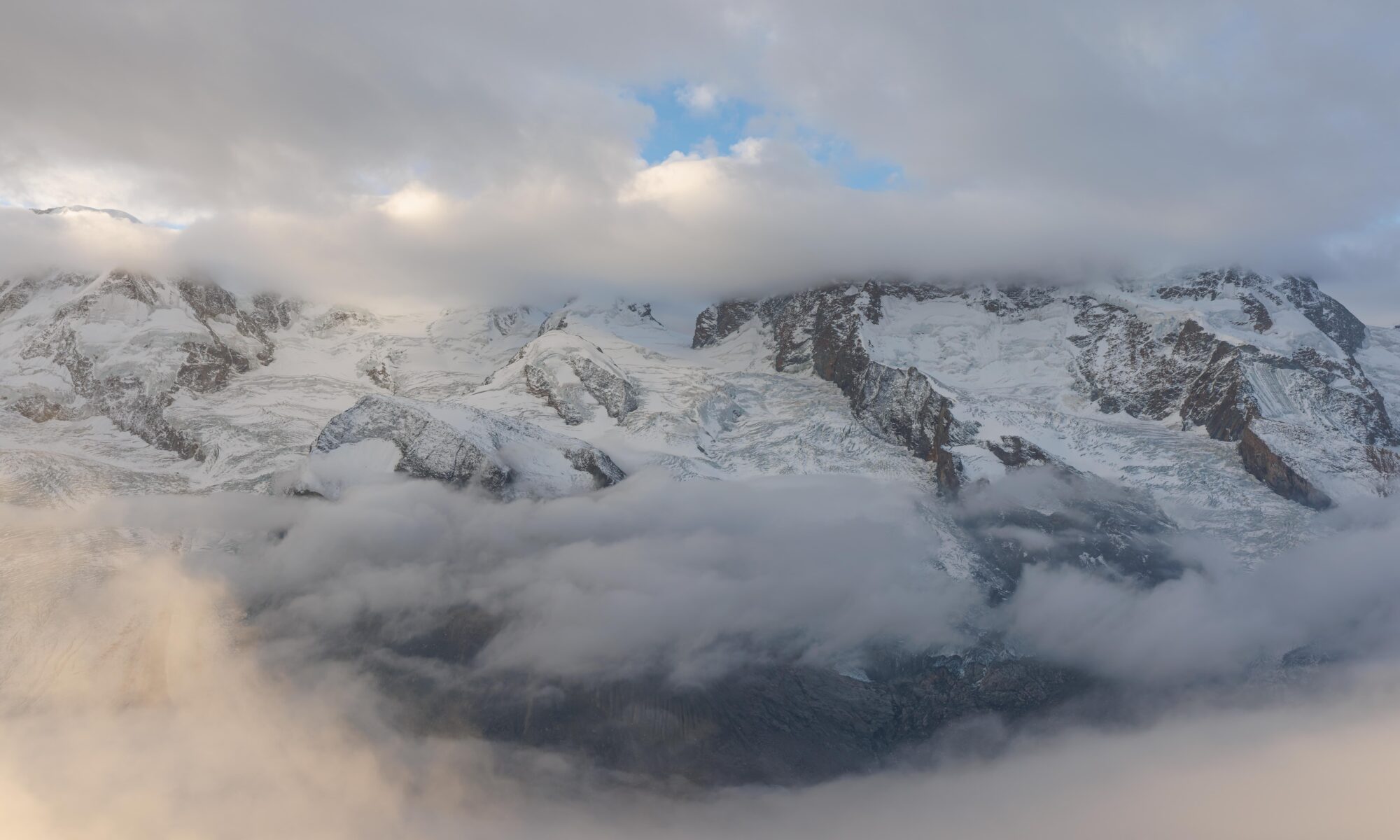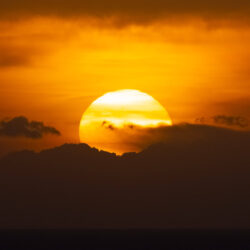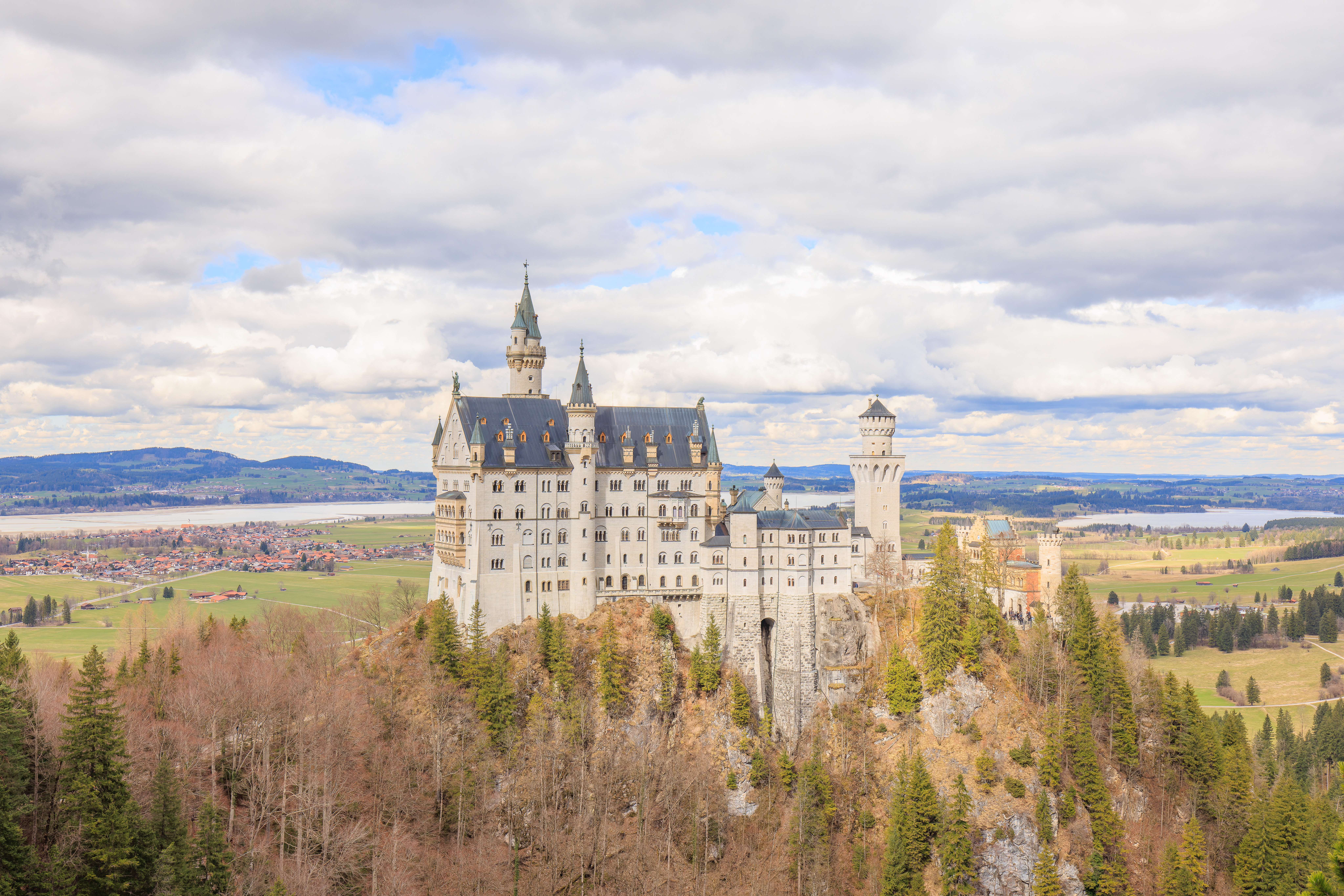For our last full day in Munich, we had breakfast as usual at the Le Méridien and then traveled to Hohenschwangau to visit Schloss Neuschwanstein, the most famous castle in Germany and the basis for Disney’s Sleeping Beauty Castle.
Morning
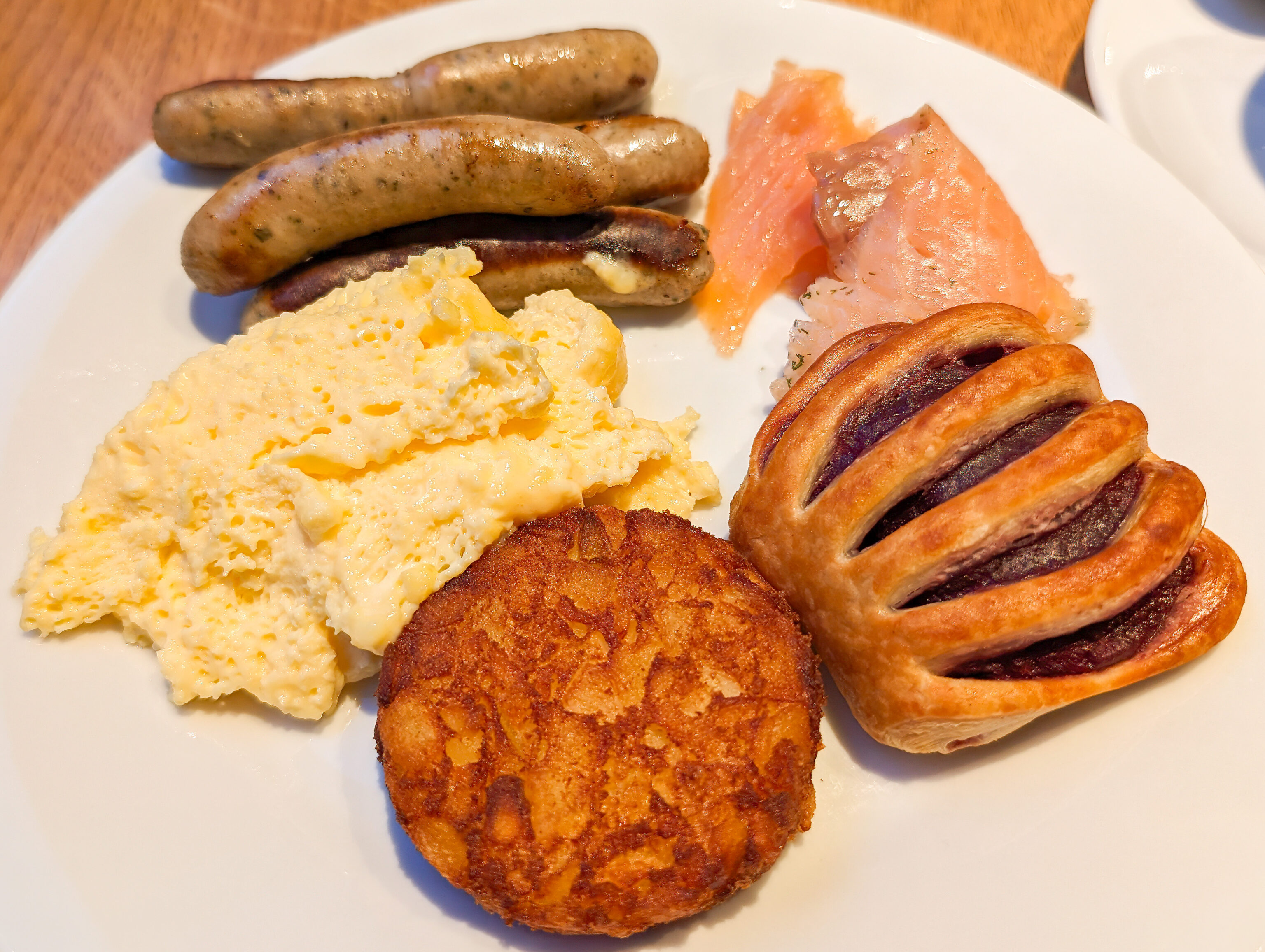
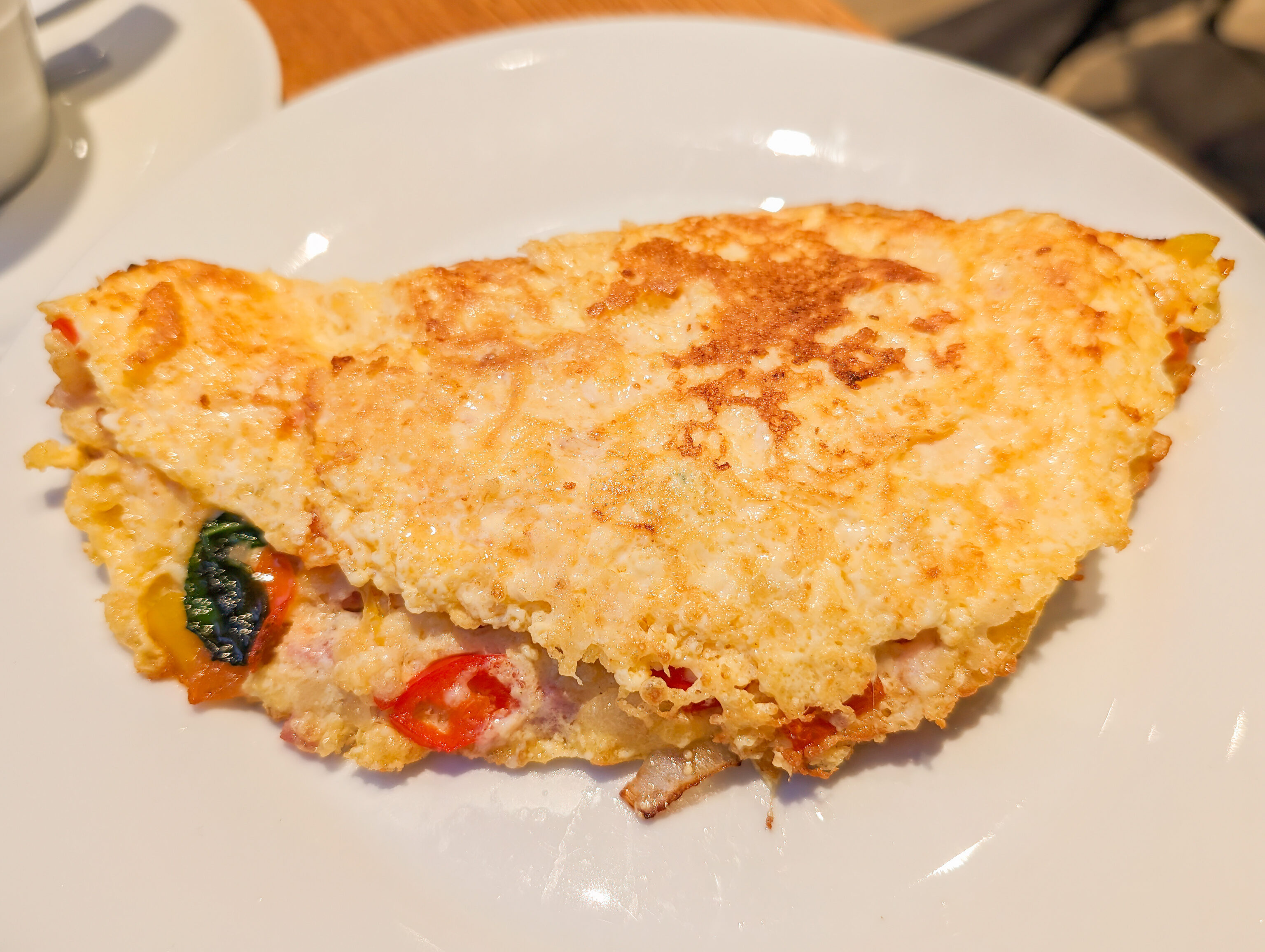
After waking up at the Le Méridien, we went downstairs for the buffet breakfast as usual. We then walked across the street to the Hauptbahnhof to begin the trip to Hohenschwangau, in southern Bavaria near the border with Austria. Hohenschwangau is actually less than 10 miles away from Zugspitze, which we visited two days ago. Despite the proximity, there is no quick route between the two locations as there are mountains in the way. Getting to Hohenschwangau by public transit generally means taking the train to Füssen and then catching a bus to Hohenschwangau.
Schloss Neuschwanstein
Hohenschwangau is home to Schloss Neuschwanstein, a castle perched atop a nearby hill. The castle’s interior can only be visited by guided tours, which can be booked in advance. The exterior of the castle can be visited for free though. We purchased tickets online for the audio tour, which is available in English and a number of other languages. There are also guided tours in German and English, though English was not available today.
From Munich, we took the train to Buchloe where we transferred to a train headed to Füssen. And from there, we caught a bus for Hohenschwangau.
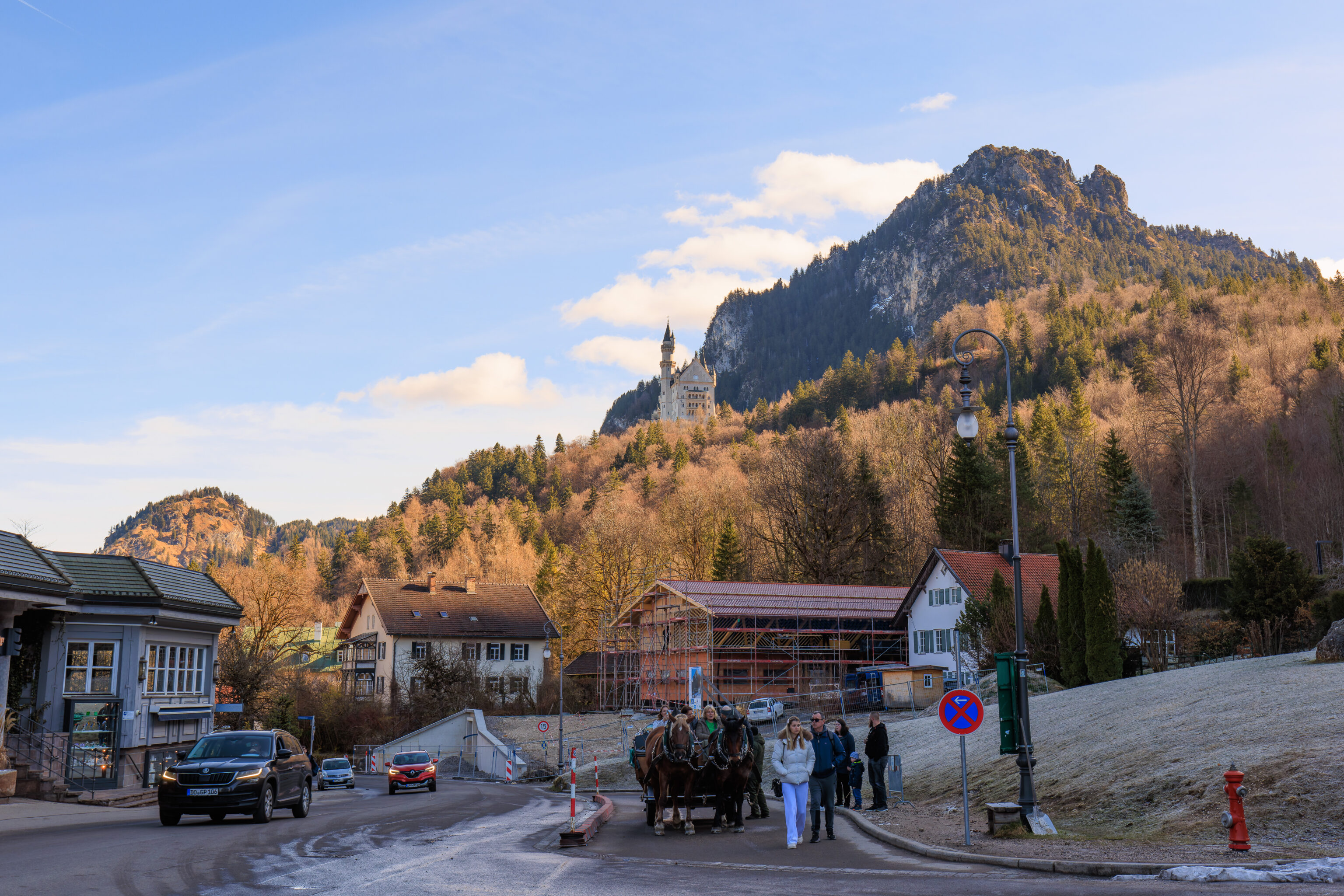
After arriving at Hohenschwangau, we followed the road to the southwest. Looking to the east, we could see Neuschwanstein on a hill above the little town.
There are a few ways to get to the castle. There is a road that goes part way up as well as walking paths that take a long route. There is also a shuttle bus as well as horse and carriage. Both are reported to be quite slow, particularly if it is busy. The horse carriages are actually motorized and don’t seem to leave until they have a full load of passengers.
From here, we turned to start walking along the road up to the castle.
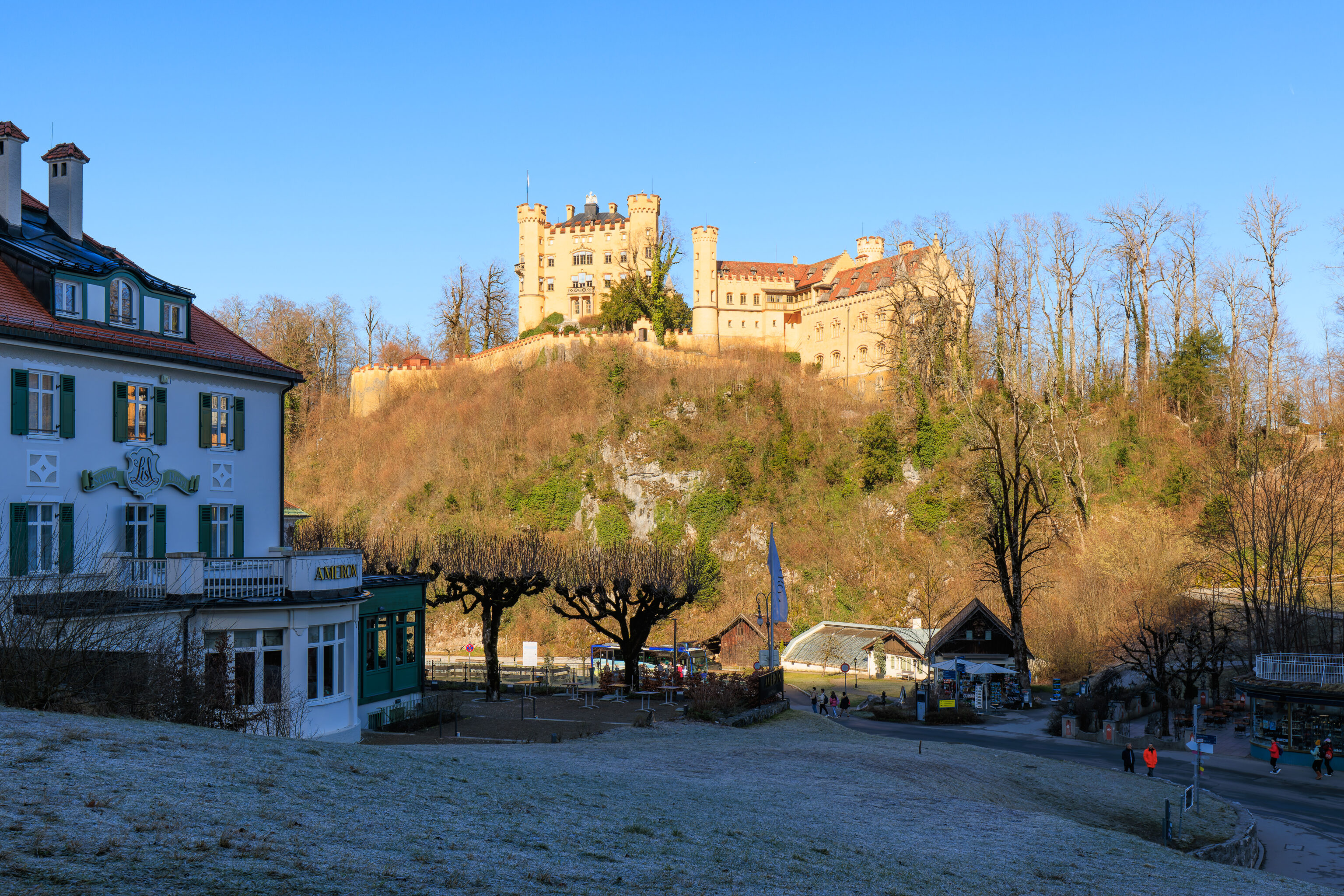
There is a second castle closer to town, Schloss Hohenschwangau. Like Neuschwanstein, the interior can only be visited on guided tour. We decided not to visit Schloss Hohenschwangau as it wasn’t possible to schedule a tour that worked with the time we had for Neuschwanstein.
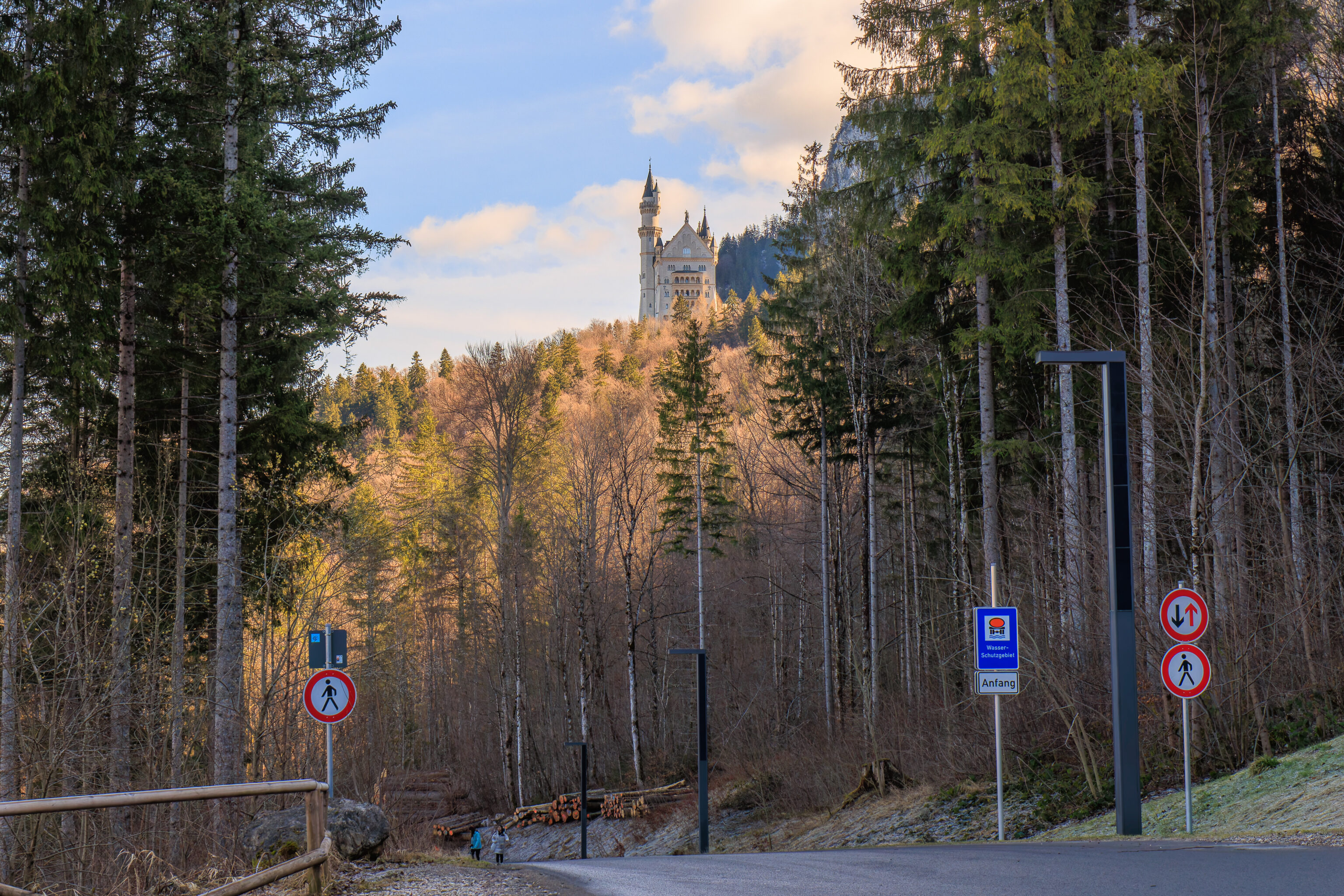
The road up leads through the forest as it ascends up to the castle.
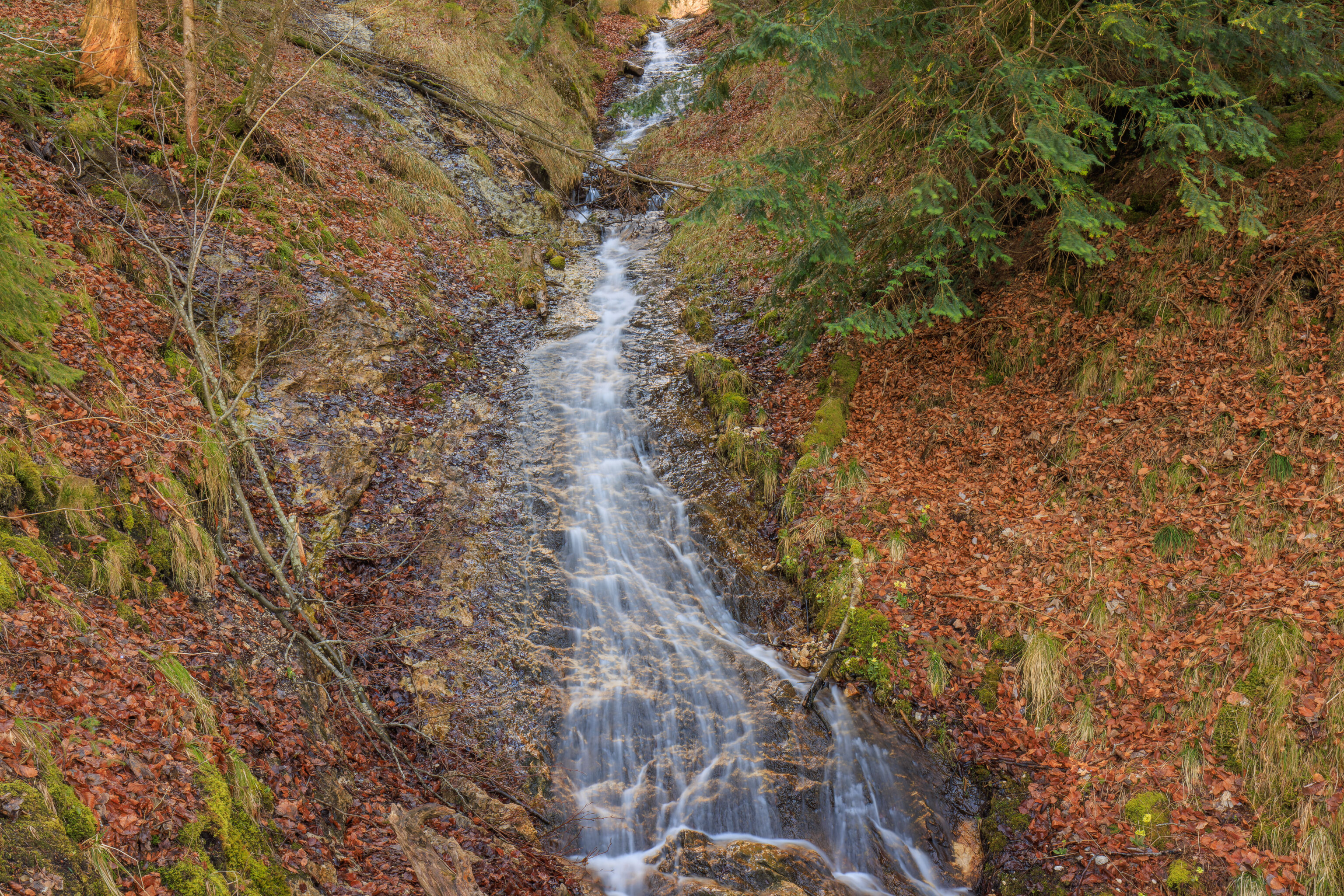
The walk up isn’t particularly interesting, though we did walk by a small waterfall.
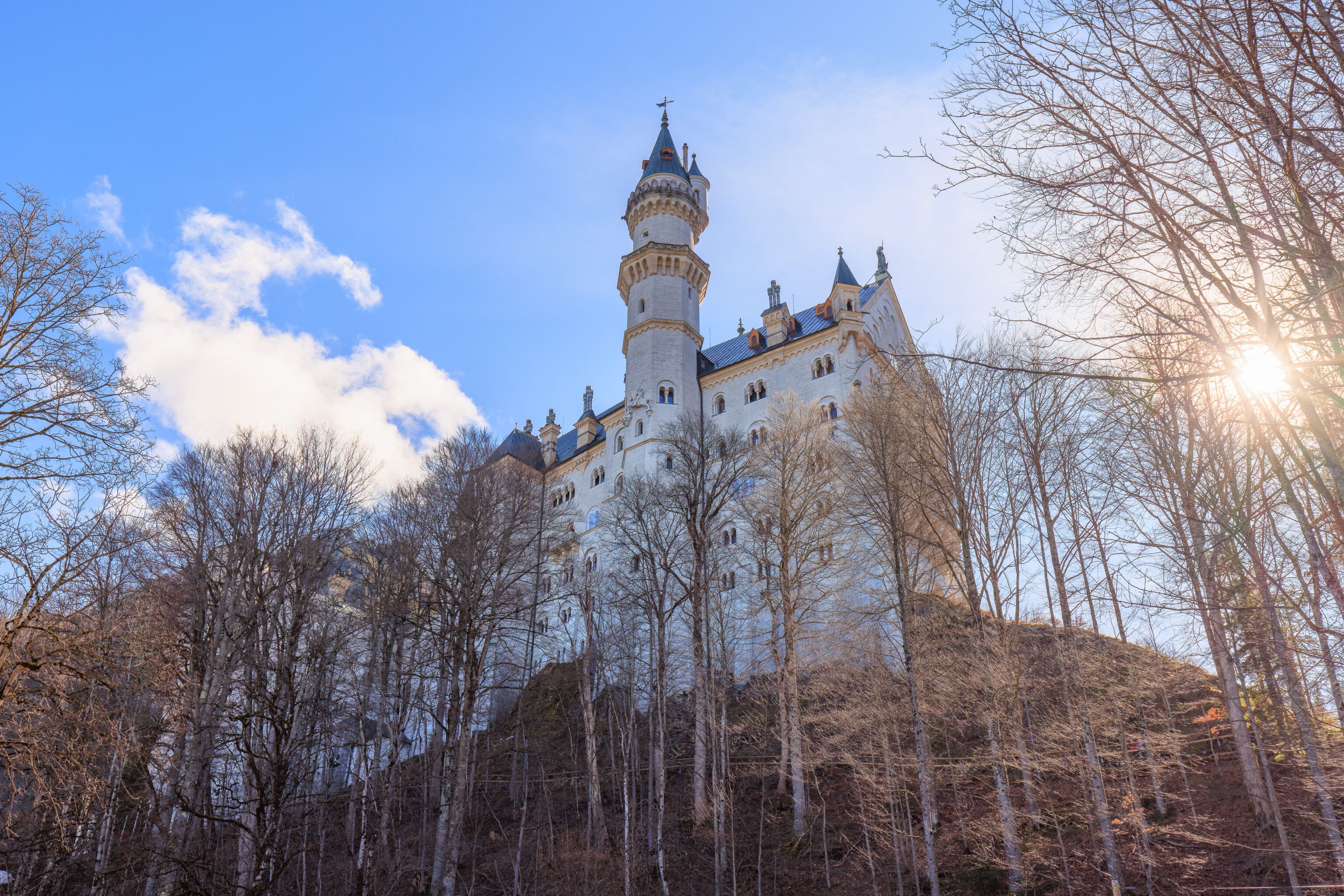
Soon, we arrived at a gift shop and poorly rated restaurant. From here, we could see the castle above us.
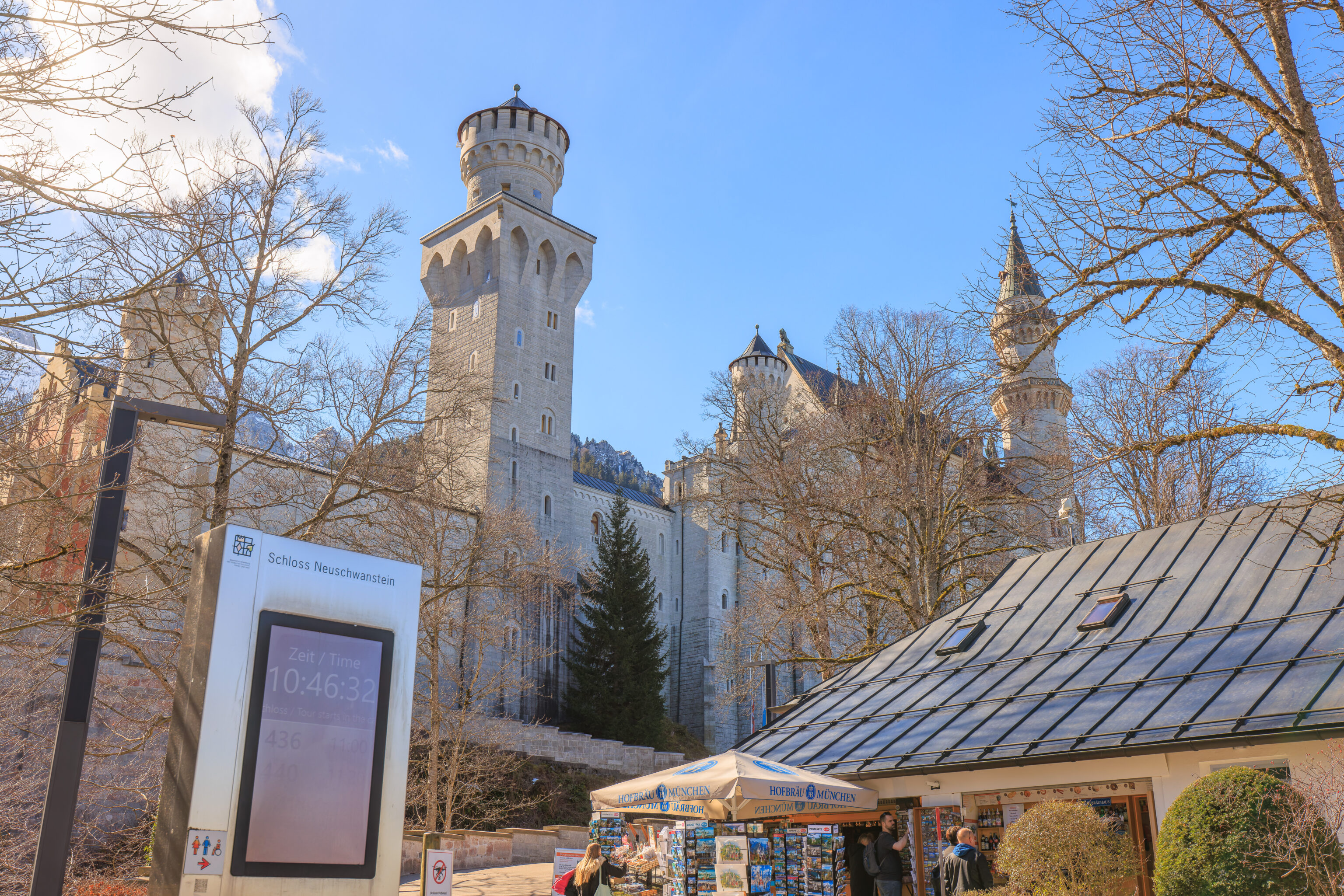
We continued a short distance to reach a gift shop and snack bar. A large display showed the time and starting times for the next few scheduled tours.
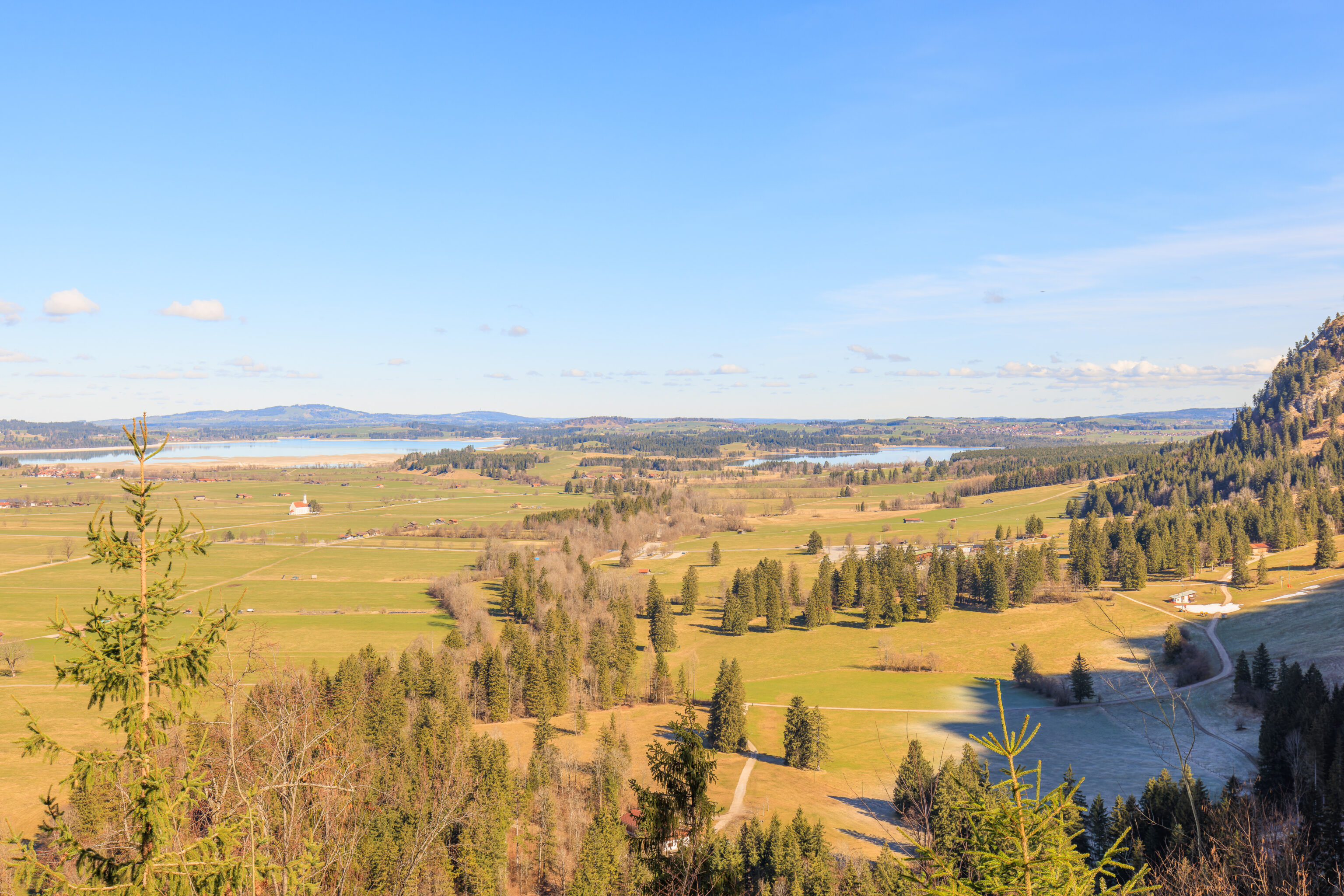
There was a nice view of the landscape to the north. The grasses below that were still in shade were covered with frost.
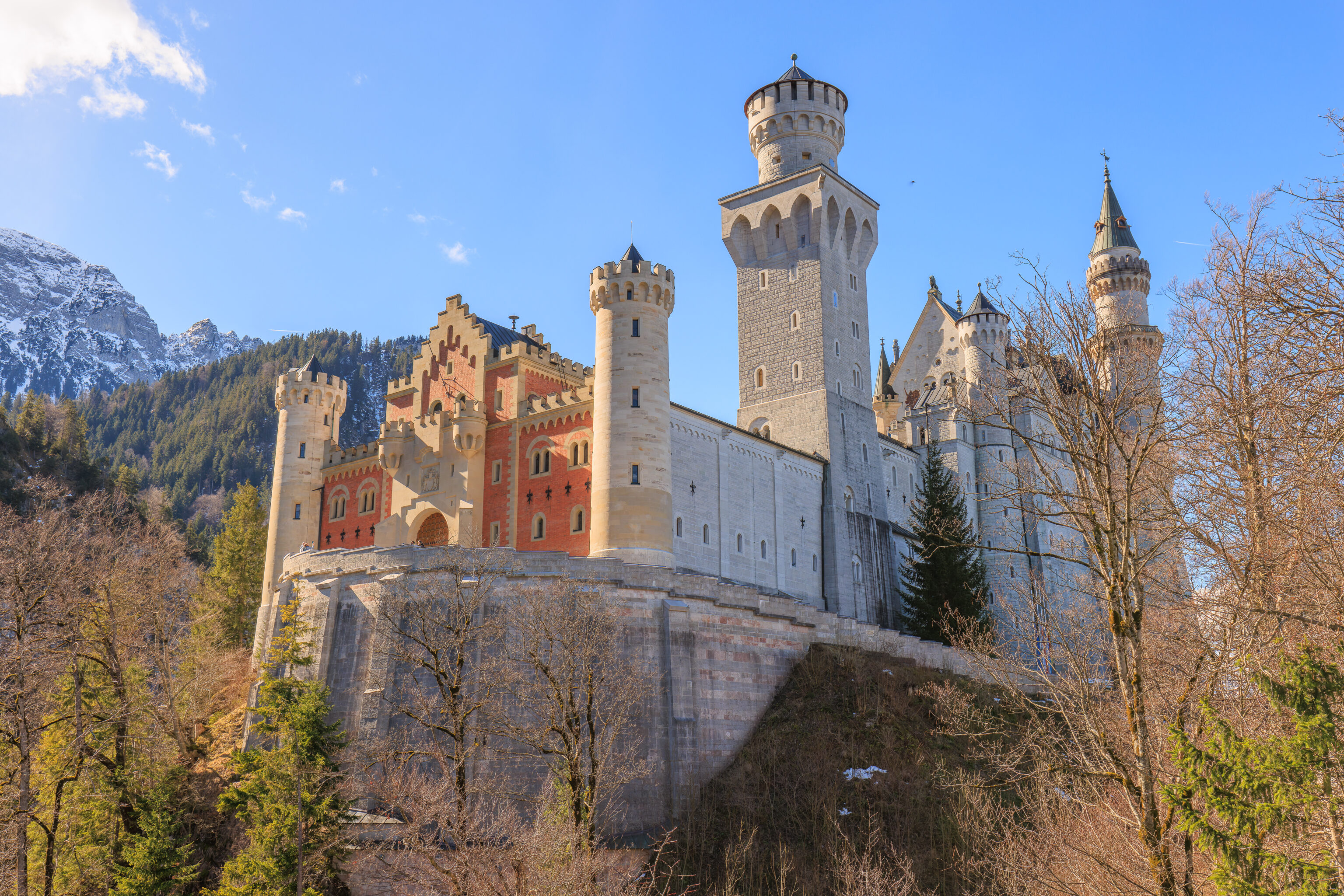
There is a nice viewing platform that provides a beautiful view of the castle from the northeast.
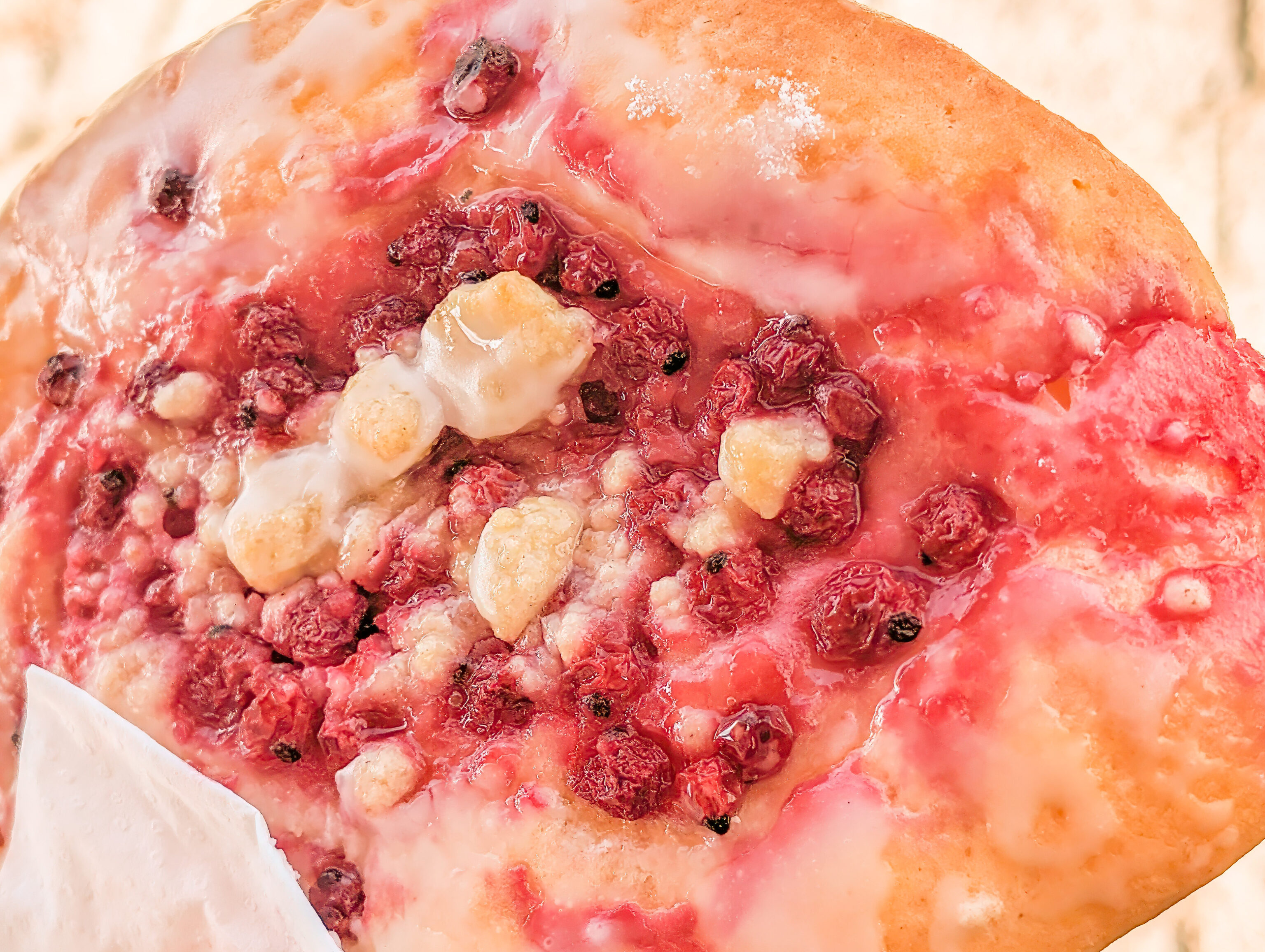
We decided to get a raspberry pastry as we were a little bit hungry and still early for our tour. It wasn’t so great.
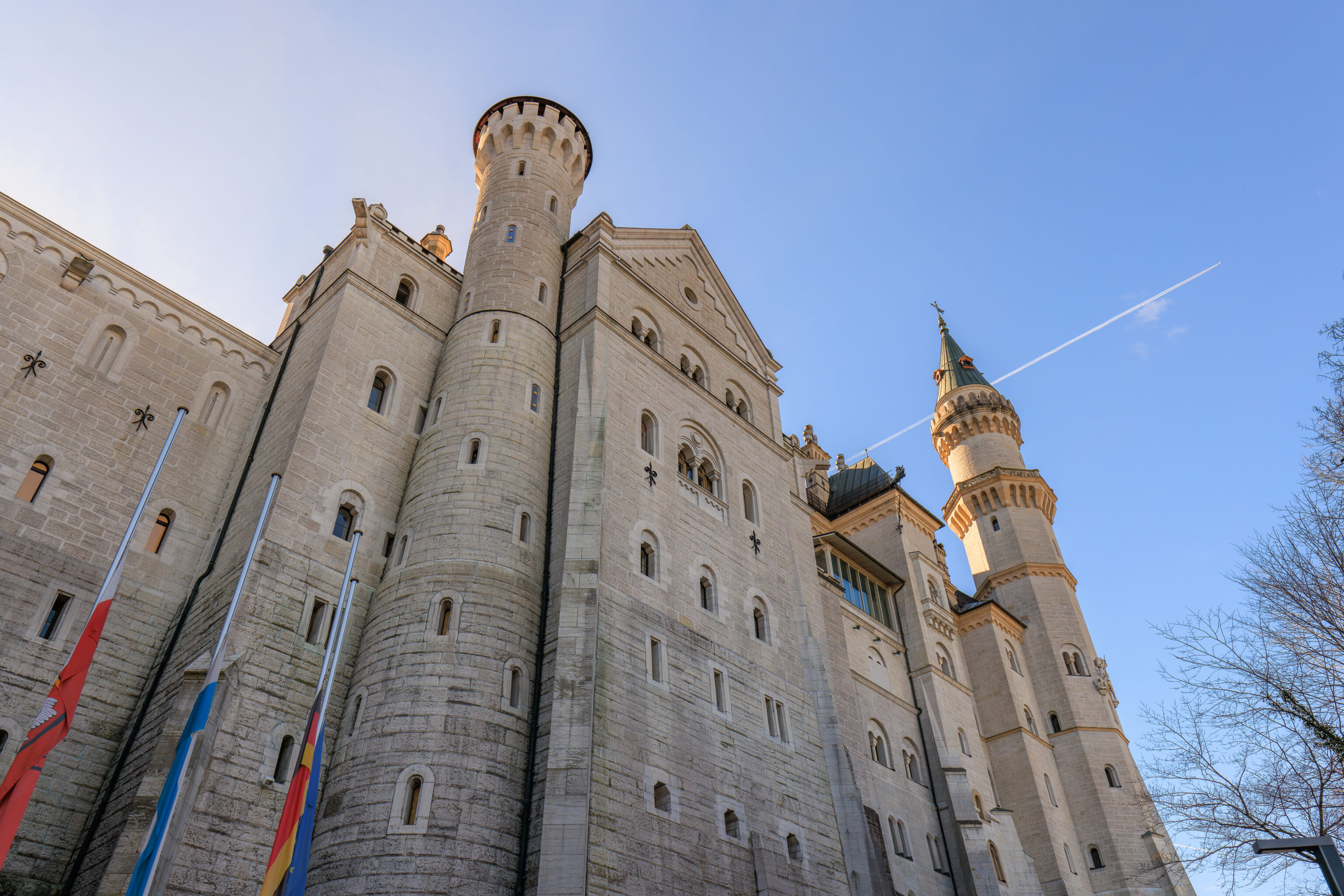
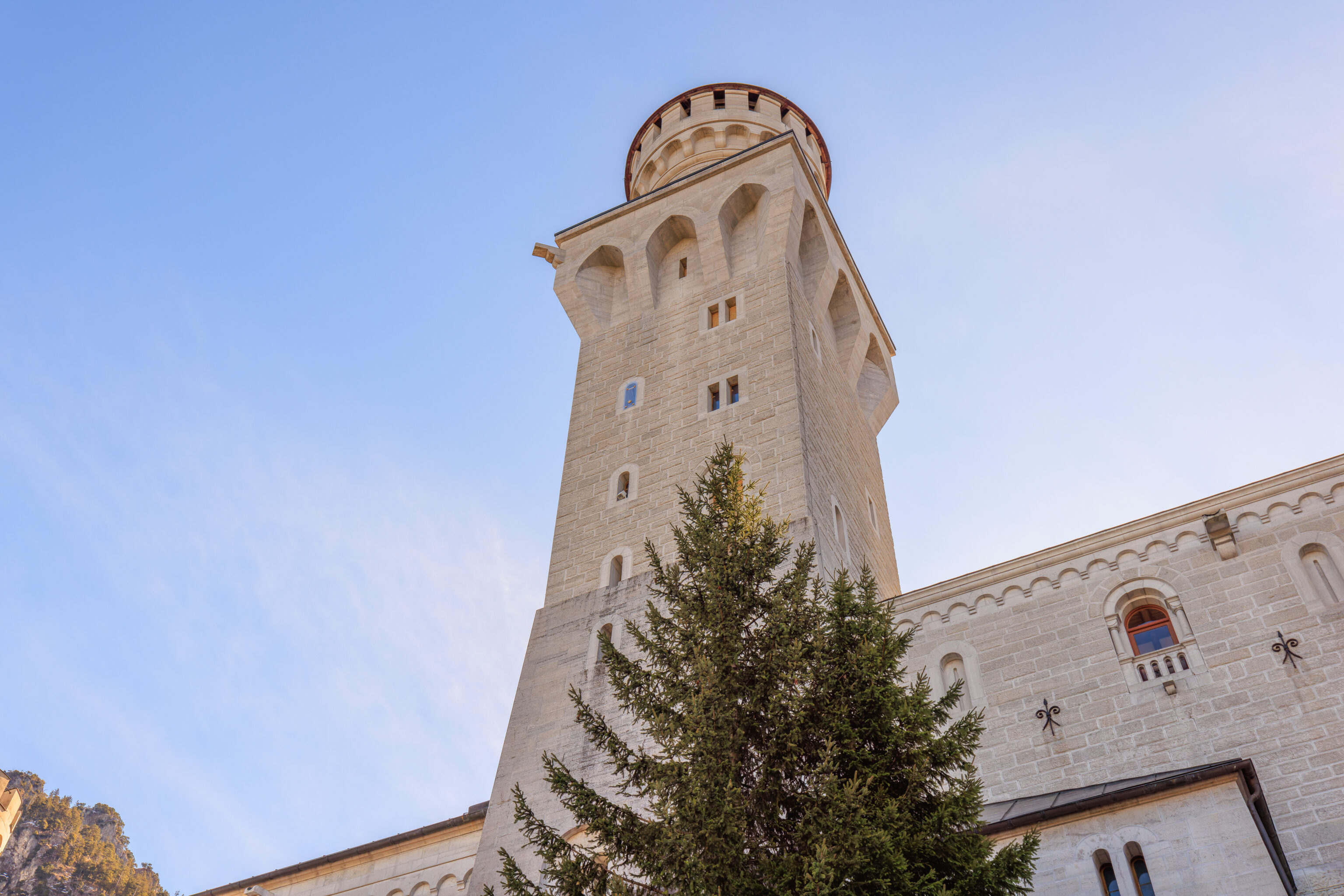
We sat around a bit before heading up to the castle.
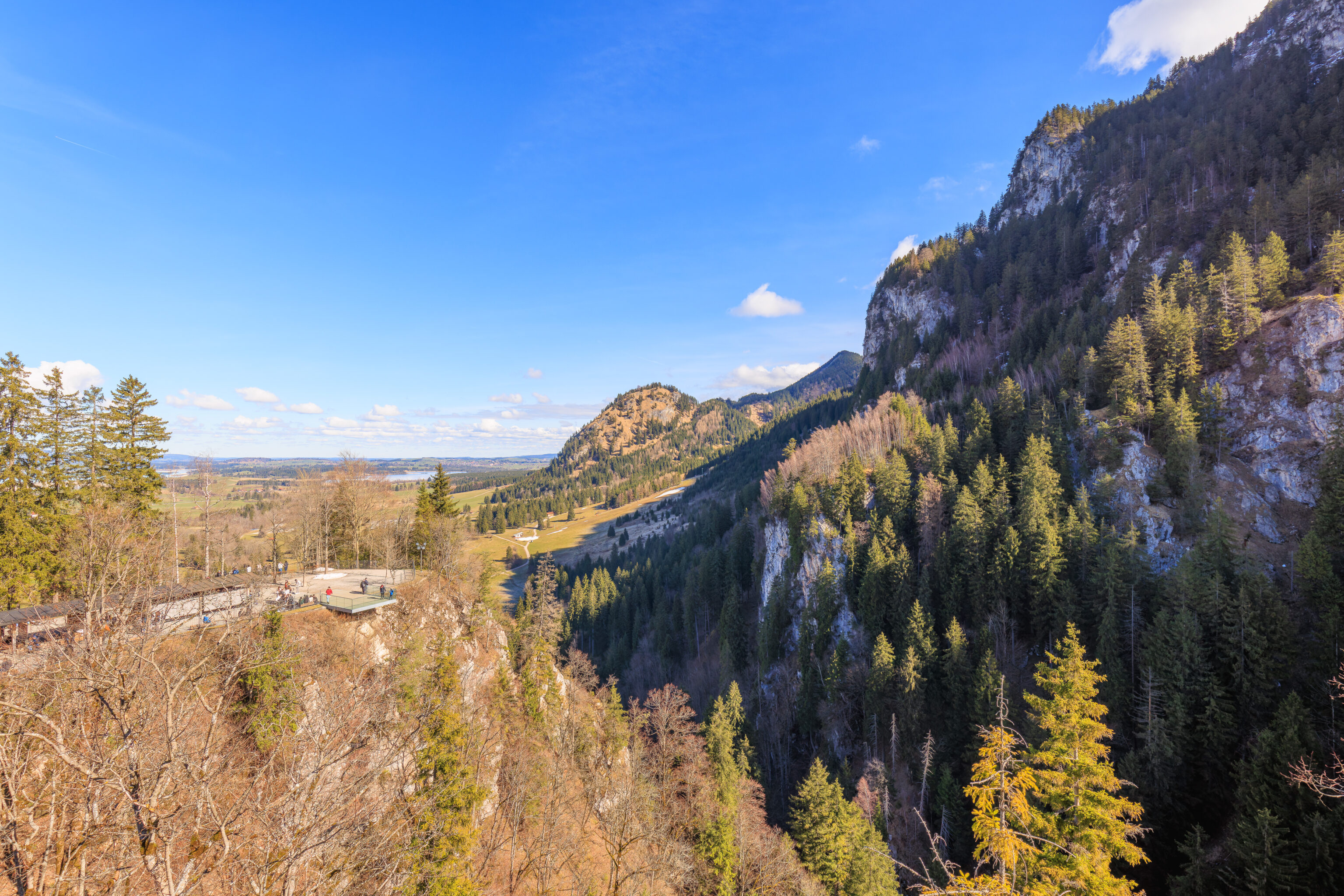
This was the view from the front of the castle by the entrance, which faces east. The viewing platform that we at before is visible at bottom left. There is a ski area directly ahead, though they don’t really have any snow right now at this elevation. There is also an aerial tram that goes up to the top of the mountain, providing access to what is supposed to be a great view as well as various hiking trails.
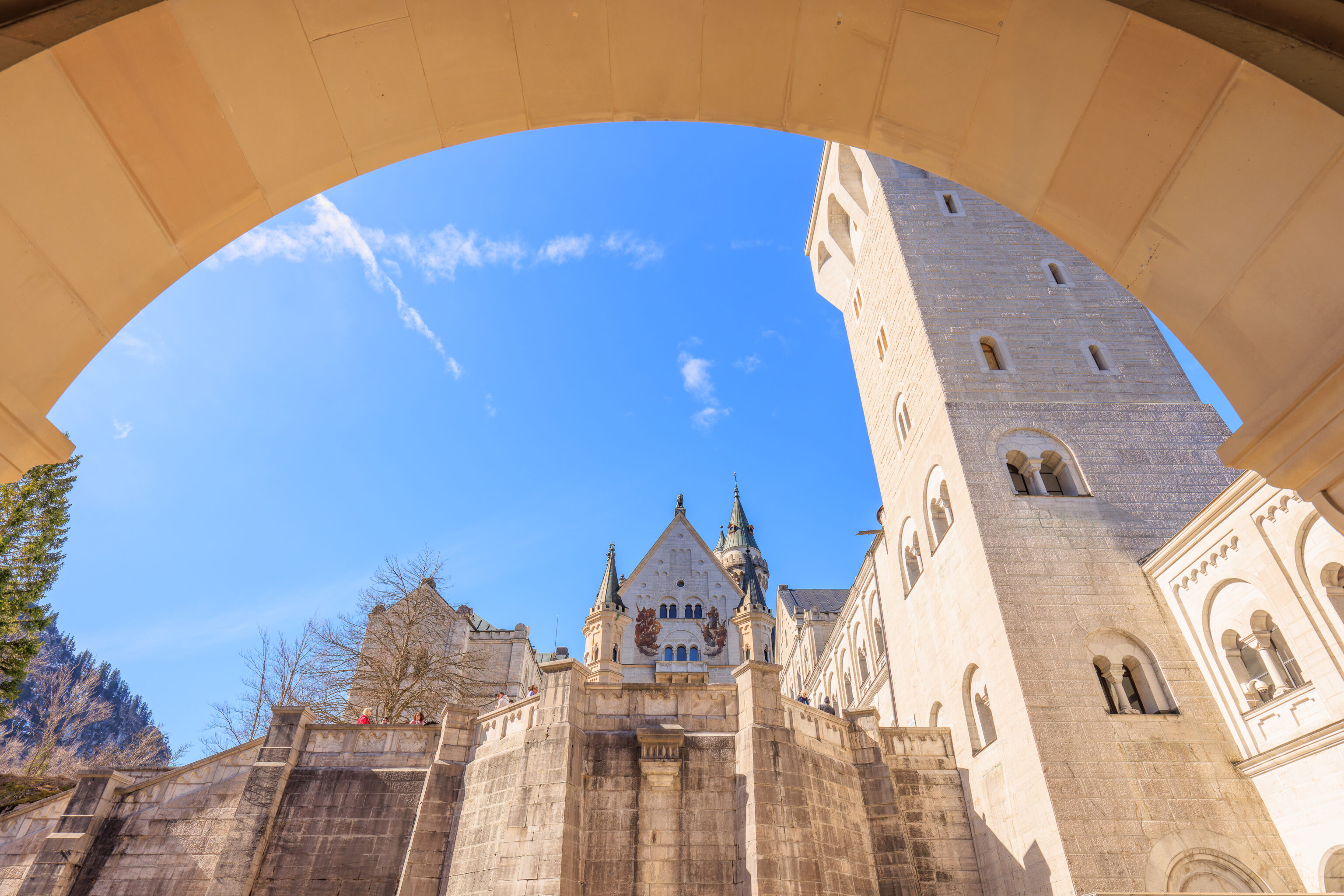
We walked through the gate to enter the castle’s lower courtyard.
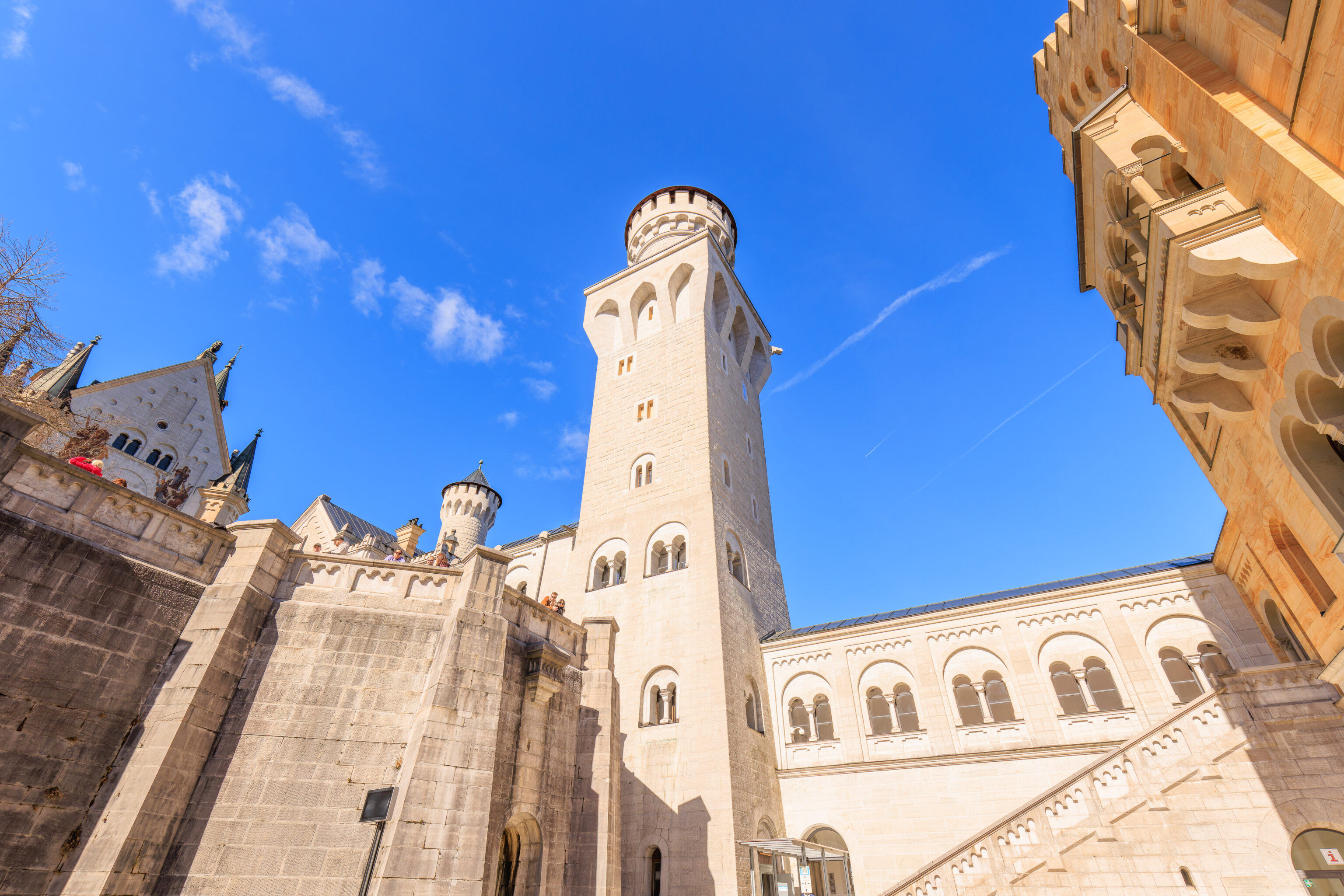
One thing we did not realize at the time is that the area to the left and above only seems to be accessible from here, which requires a ticket to enter. Unfortunately, we didn’t go up there as the tour begins below the turret at the center of this photo.
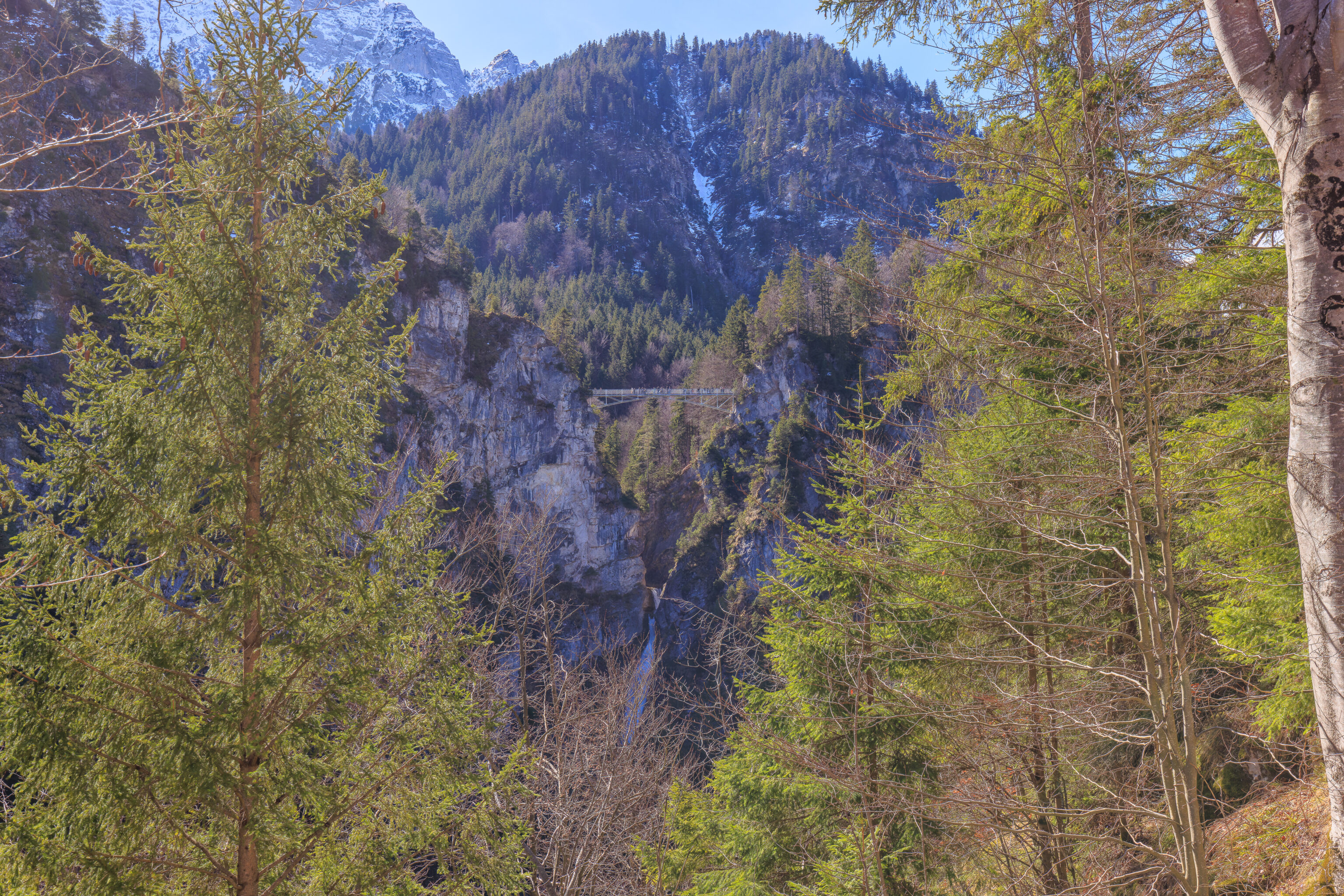
There is a bridge, the Marienbrücke, to the south of the castle. It is supposed to offer an excellent view of the castle. We plan on going there after the tour.
Unfortunately, photography is not permitted on the tour. The castle’s website does have a page which shows the tour route and provides a few tiny photos. The castle’s not very active Facebook page did post a few beautiful photos of the interior two years ago:
The general story of this castle is that it was built by King Ludwig II, who was responsible for building many castles here in Bavaria. He intended it to be sort of a fairy tale castle, resulting in what we see here today. This castle is known as being the basis for Disney’s castles, particularly the Sleeping Beauty Castle in Disneyland. He spent all his time, effort, and money on building his castles and neglected royal duties.
He was ultimately declared insane, detained, and likely murdered.
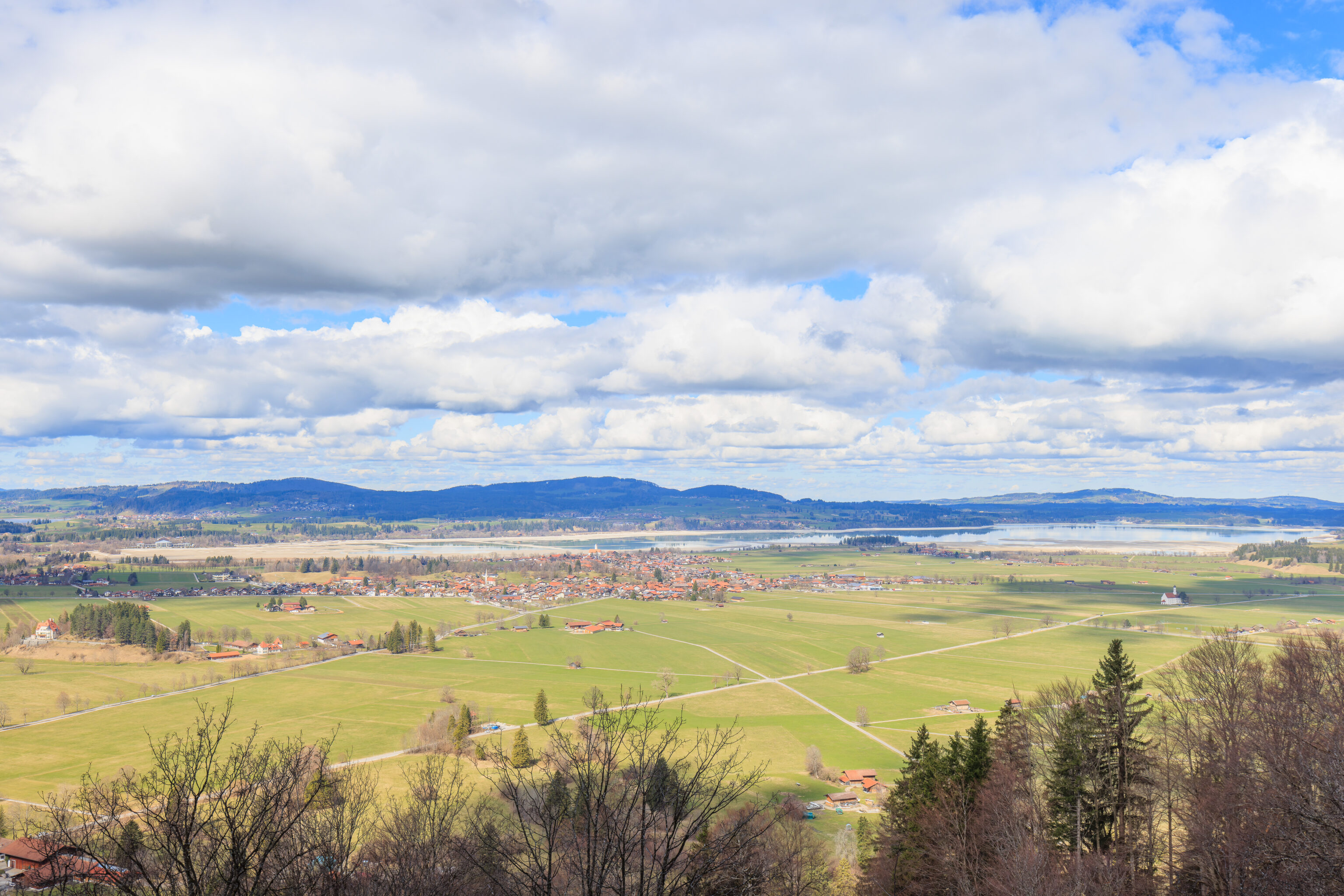
There are some spots near the end of the tour where the landscape below can be seen.
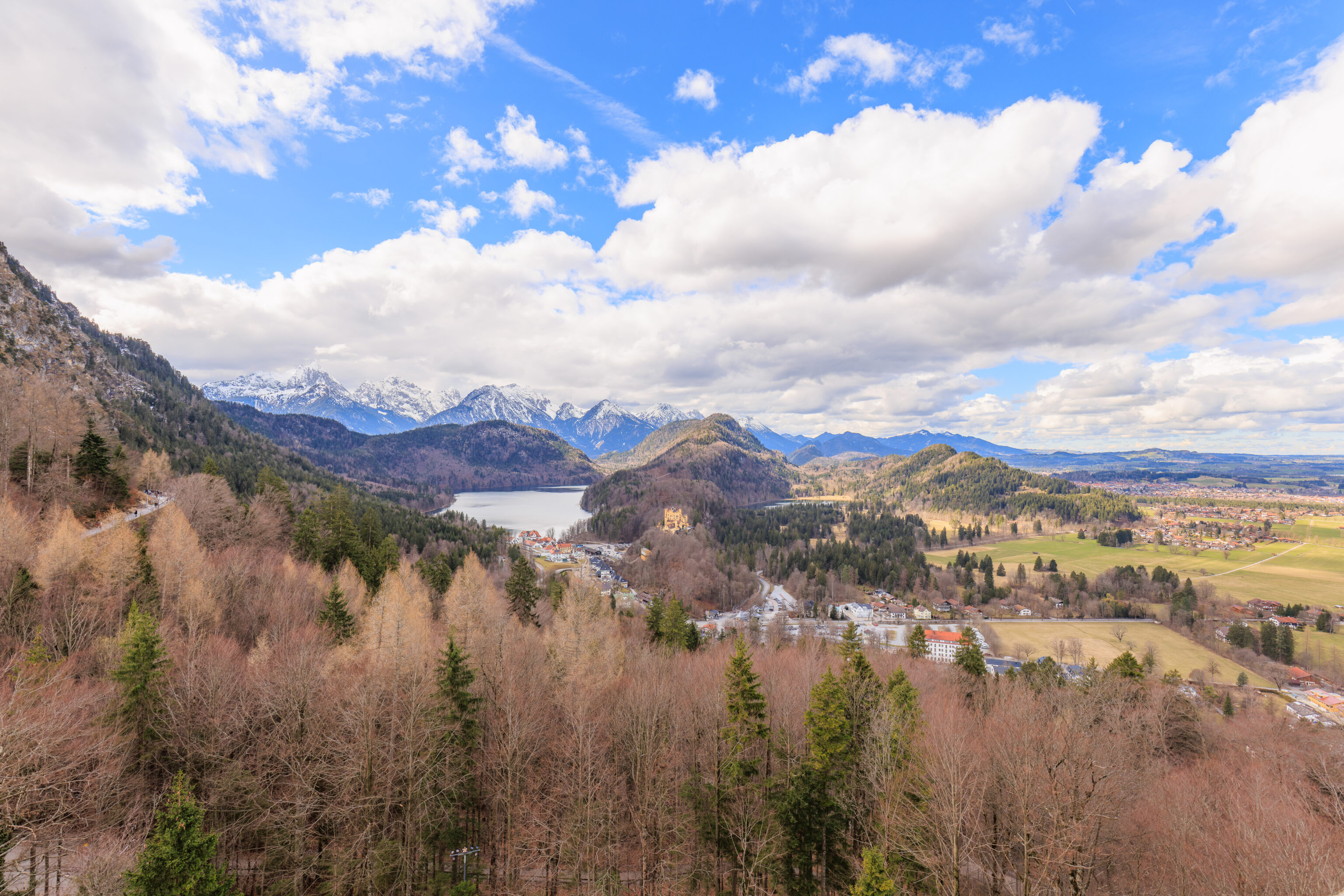
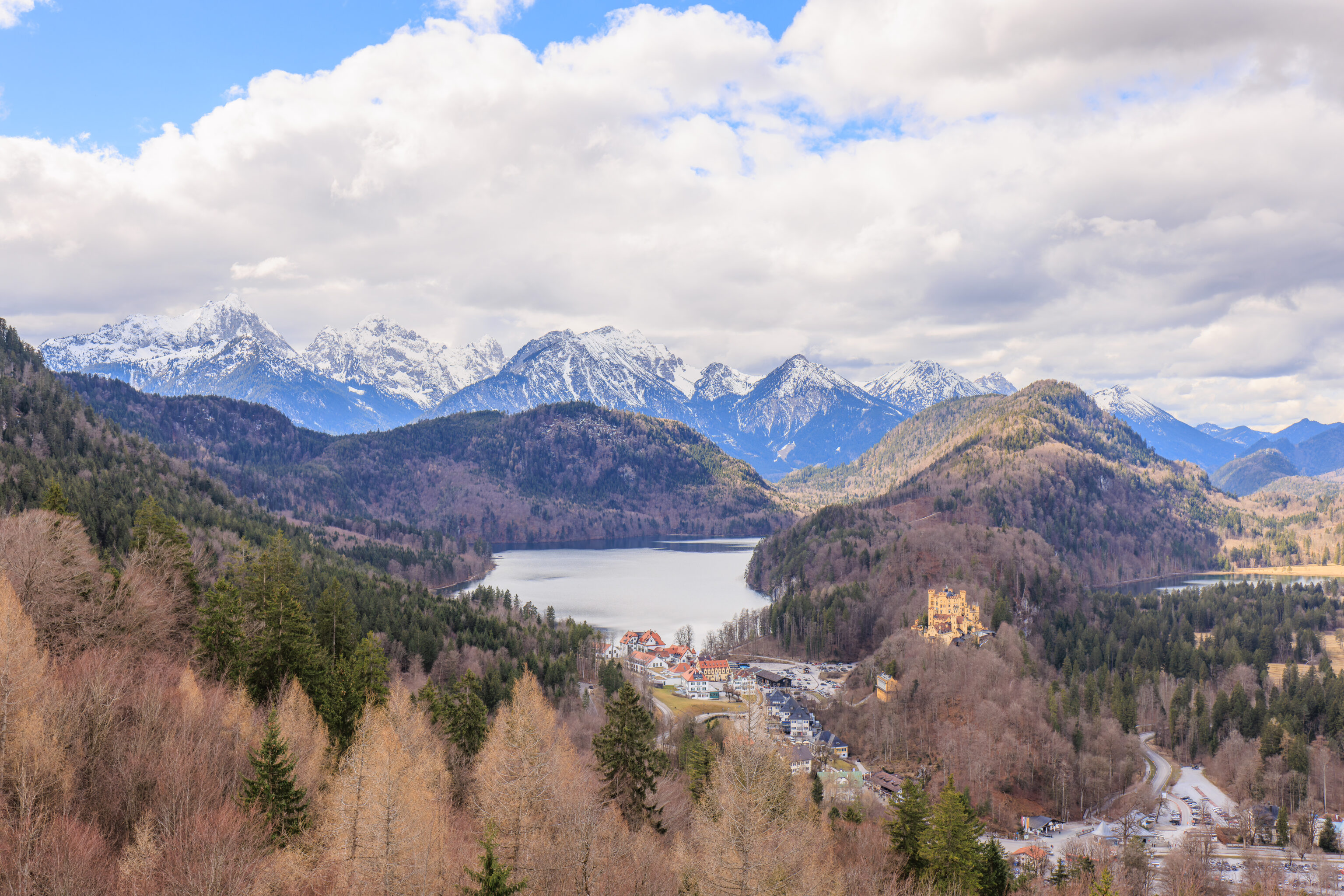
We could see the tiny town of Hohenschwangau below from a wide balcony on the west end of the castle.
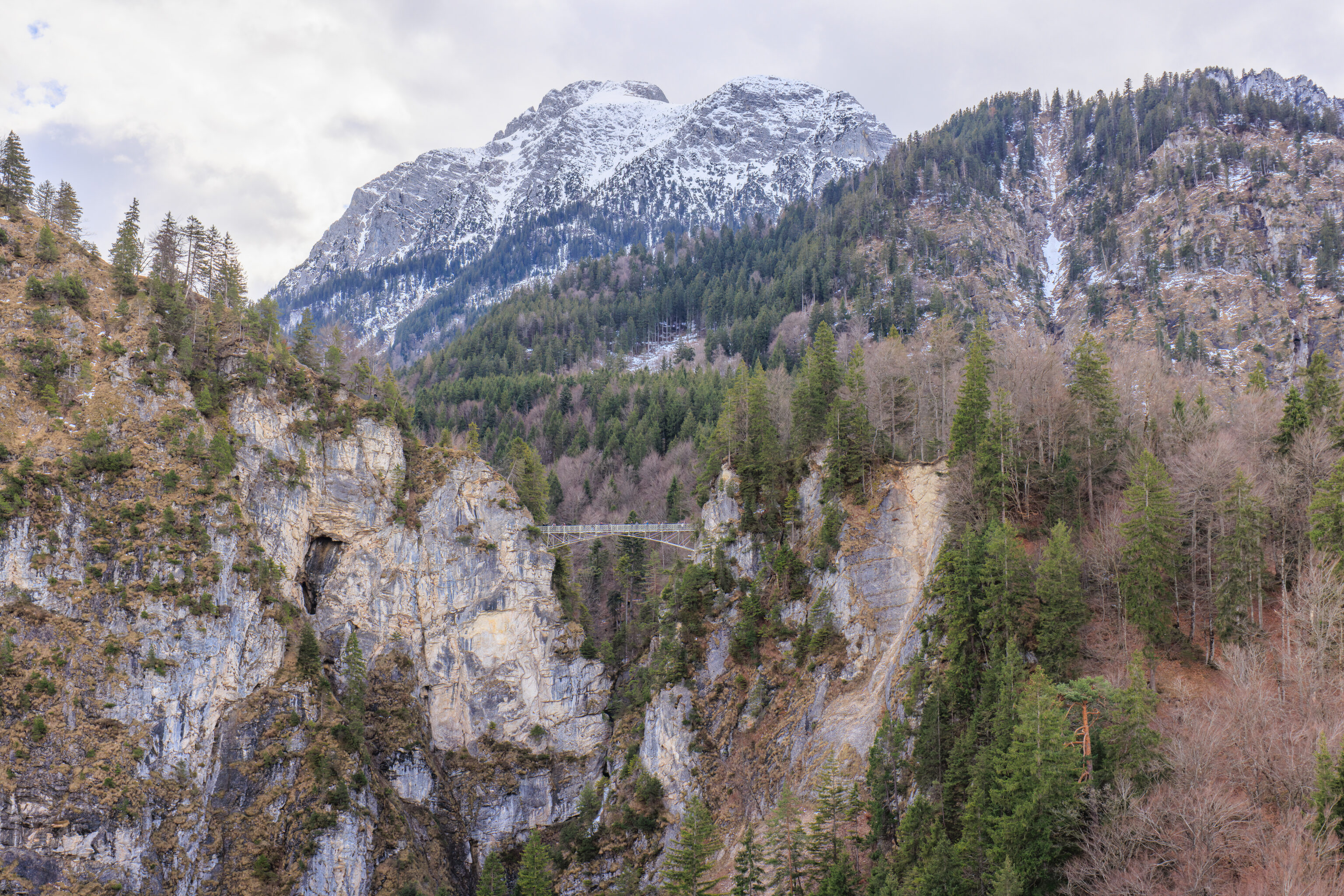
We could also see the Marienbrücke clearly from here.
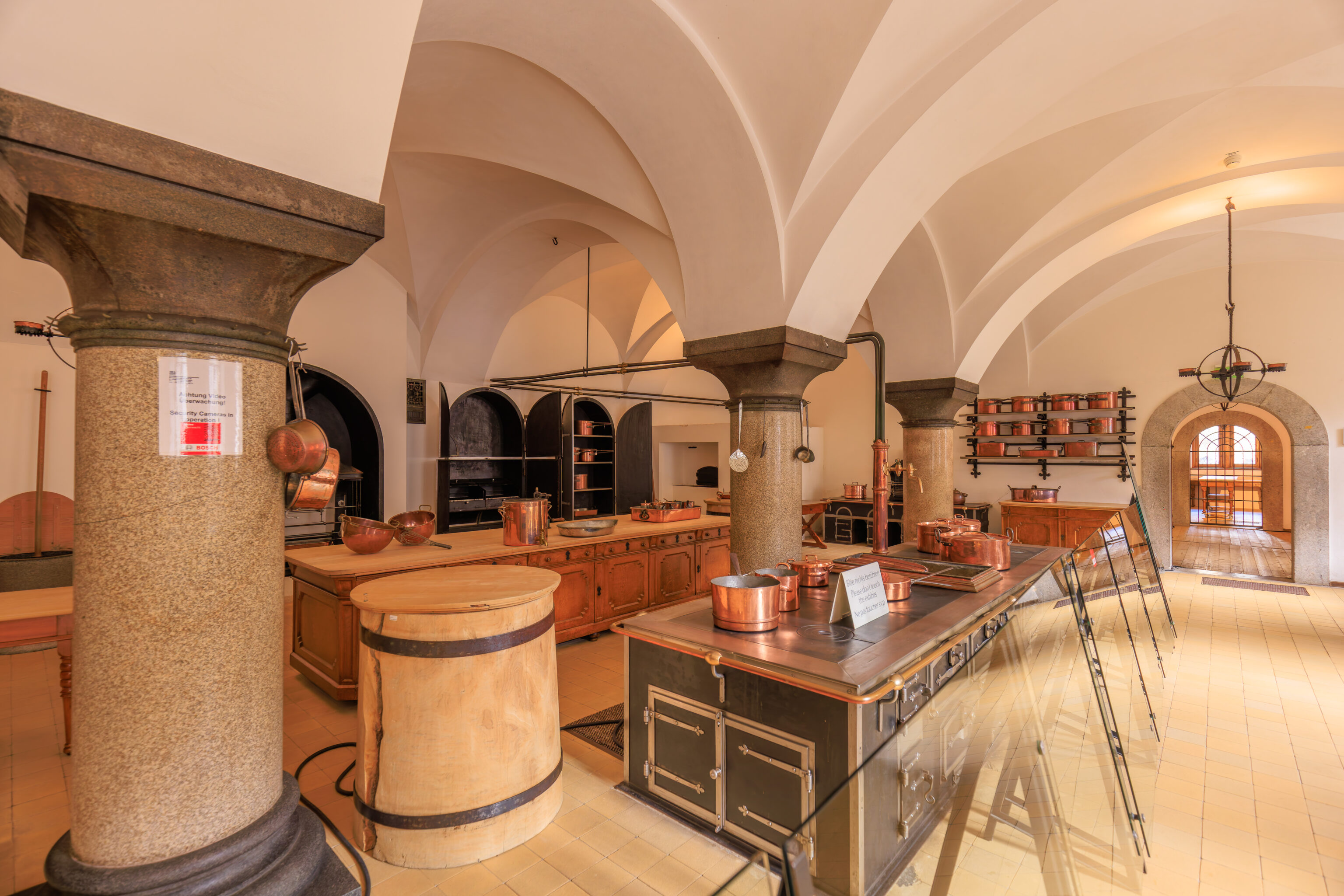
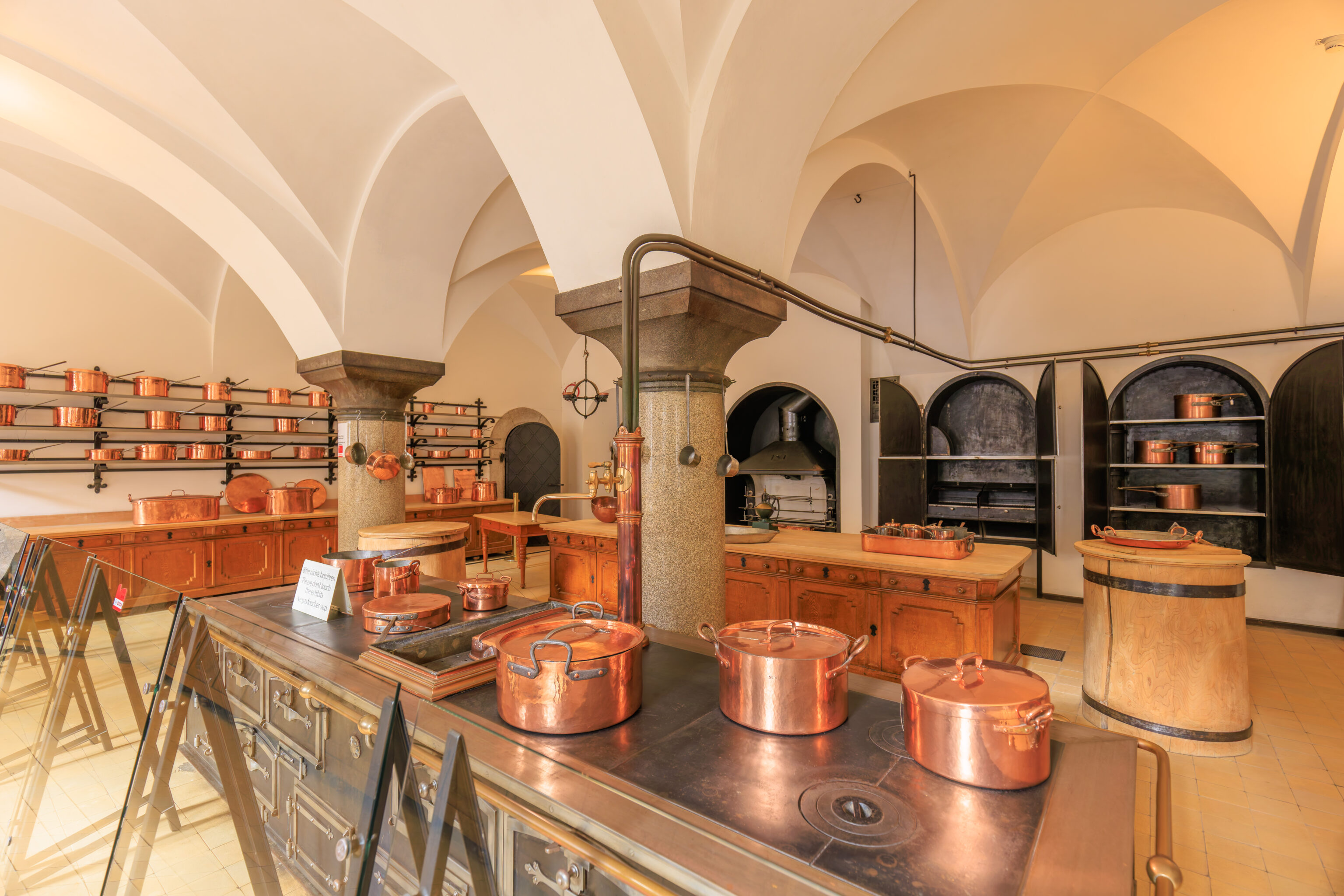
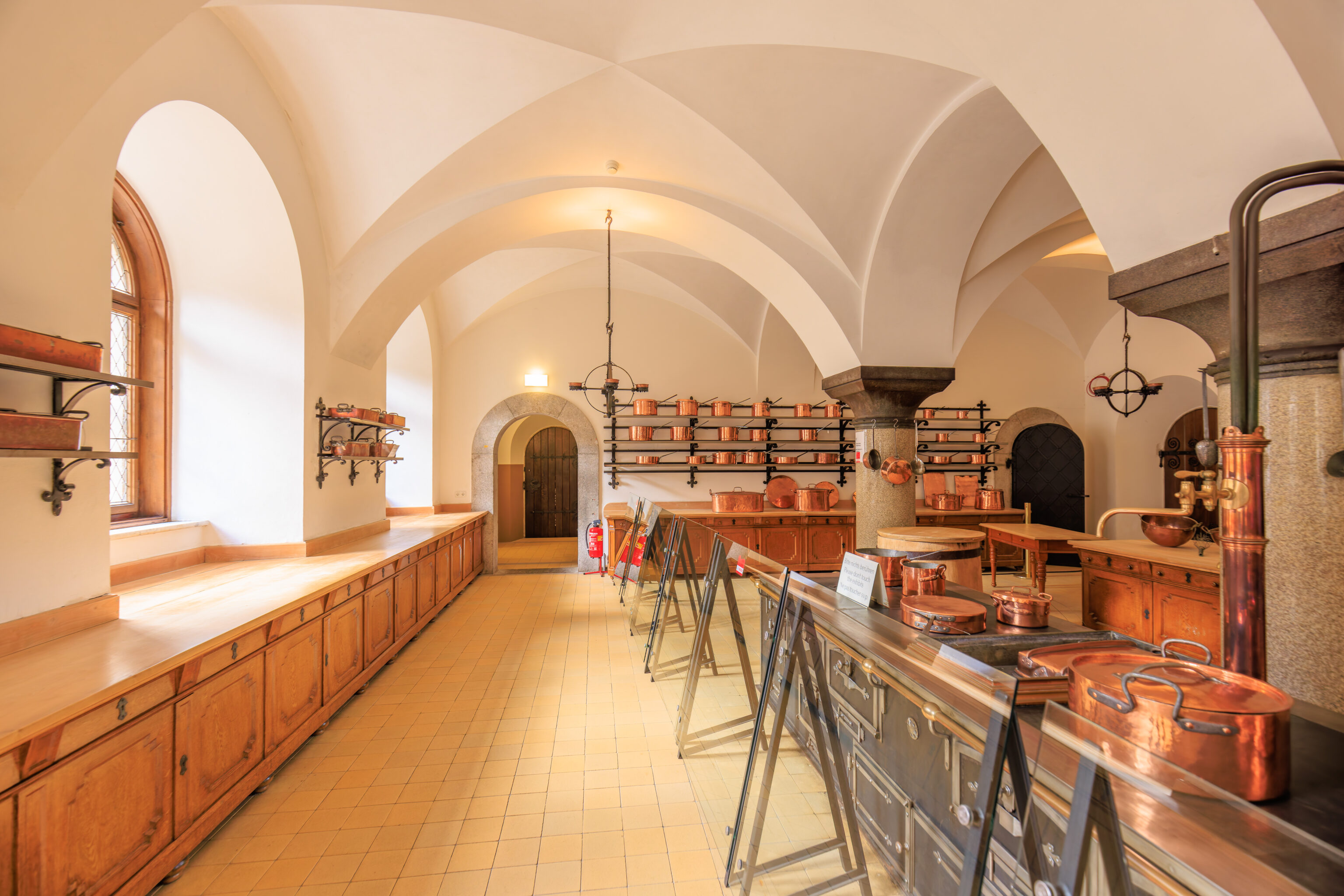
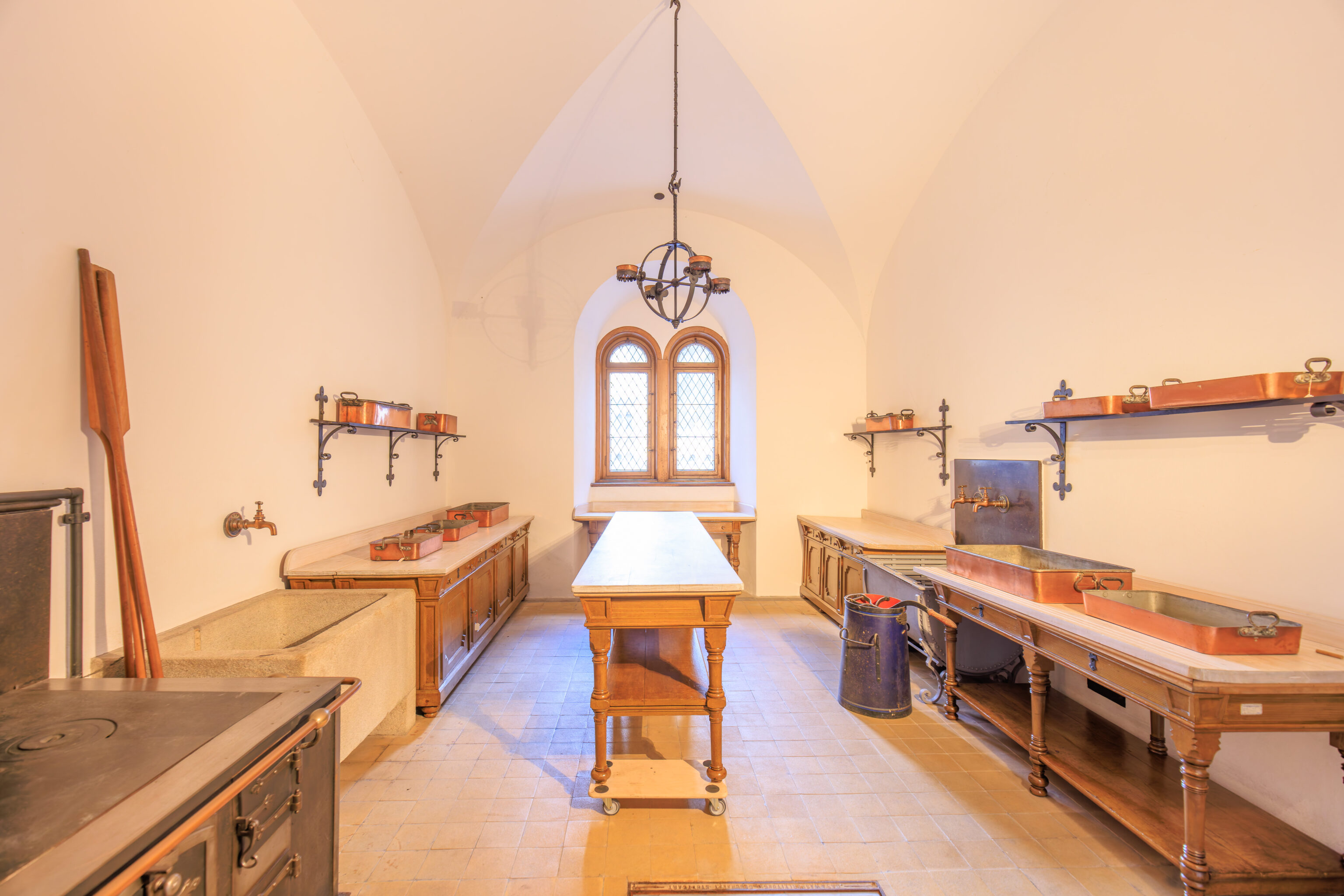
The only interior area that can be photographed is this kitchen that you pass through on the way out of the castle.
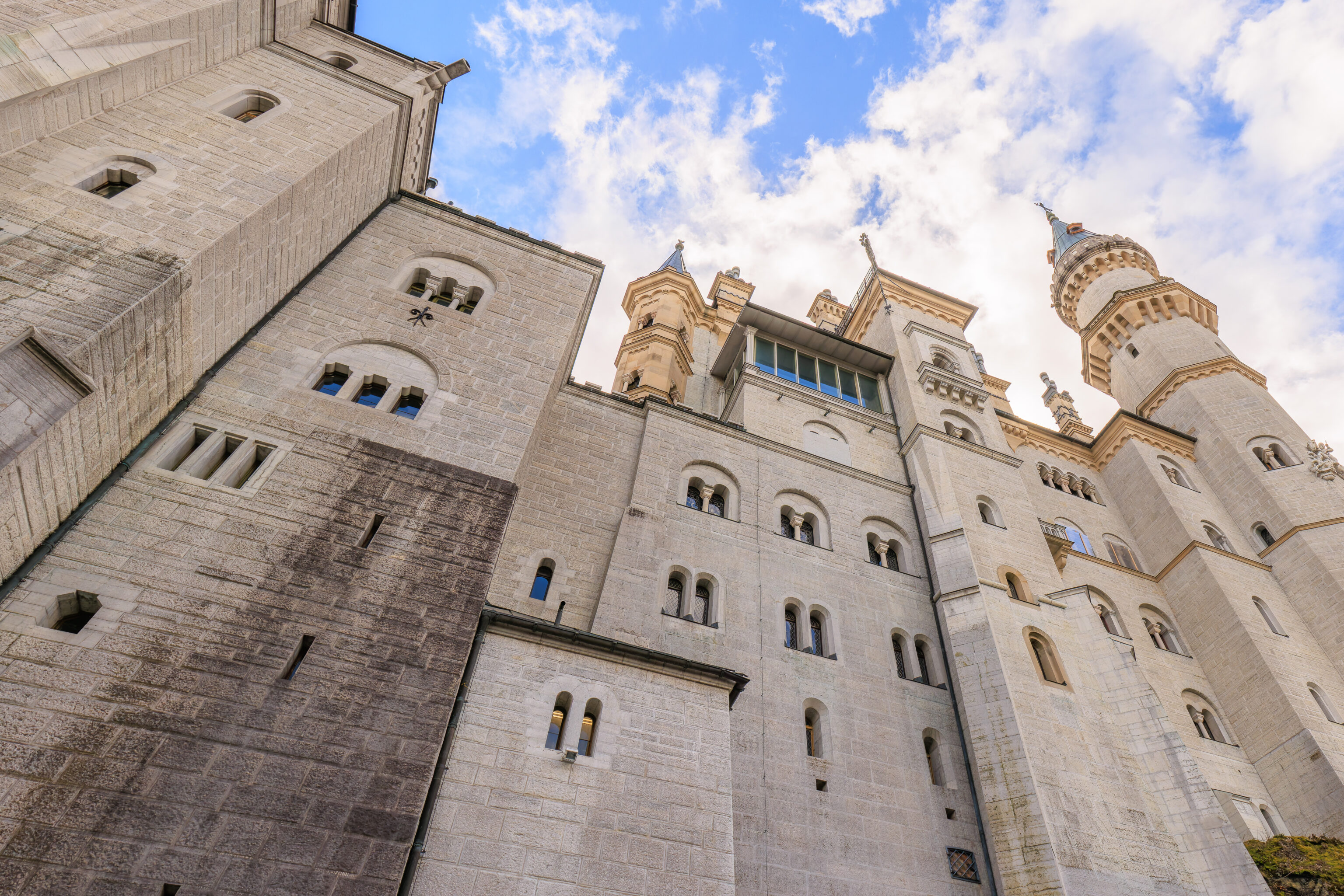
The route through the castle ends here, on the north side of the castle right next to the path that leads to the entrance.
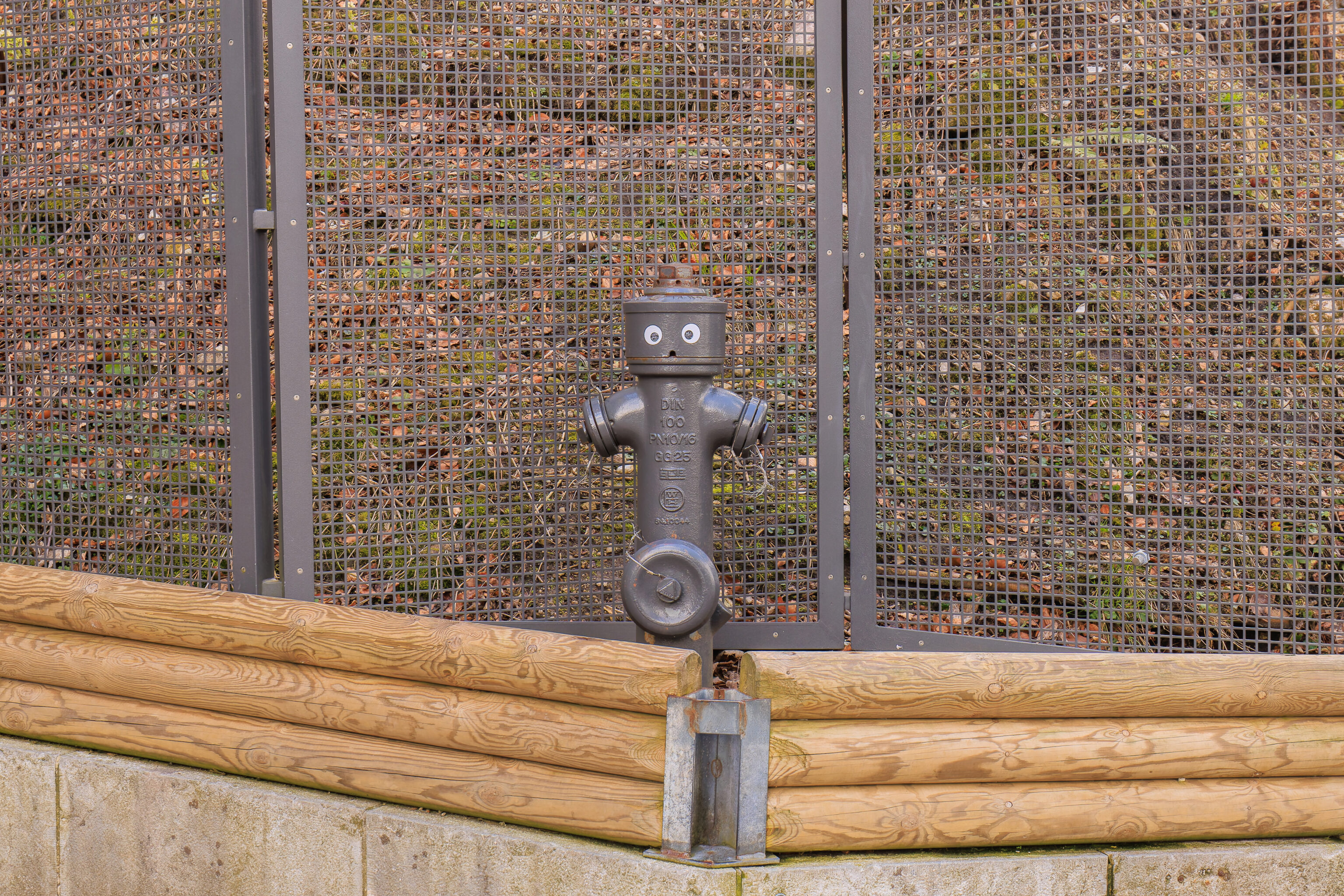
We noticed this little fire hydrant with googly eyes nearby! Did a visitor stick them on?
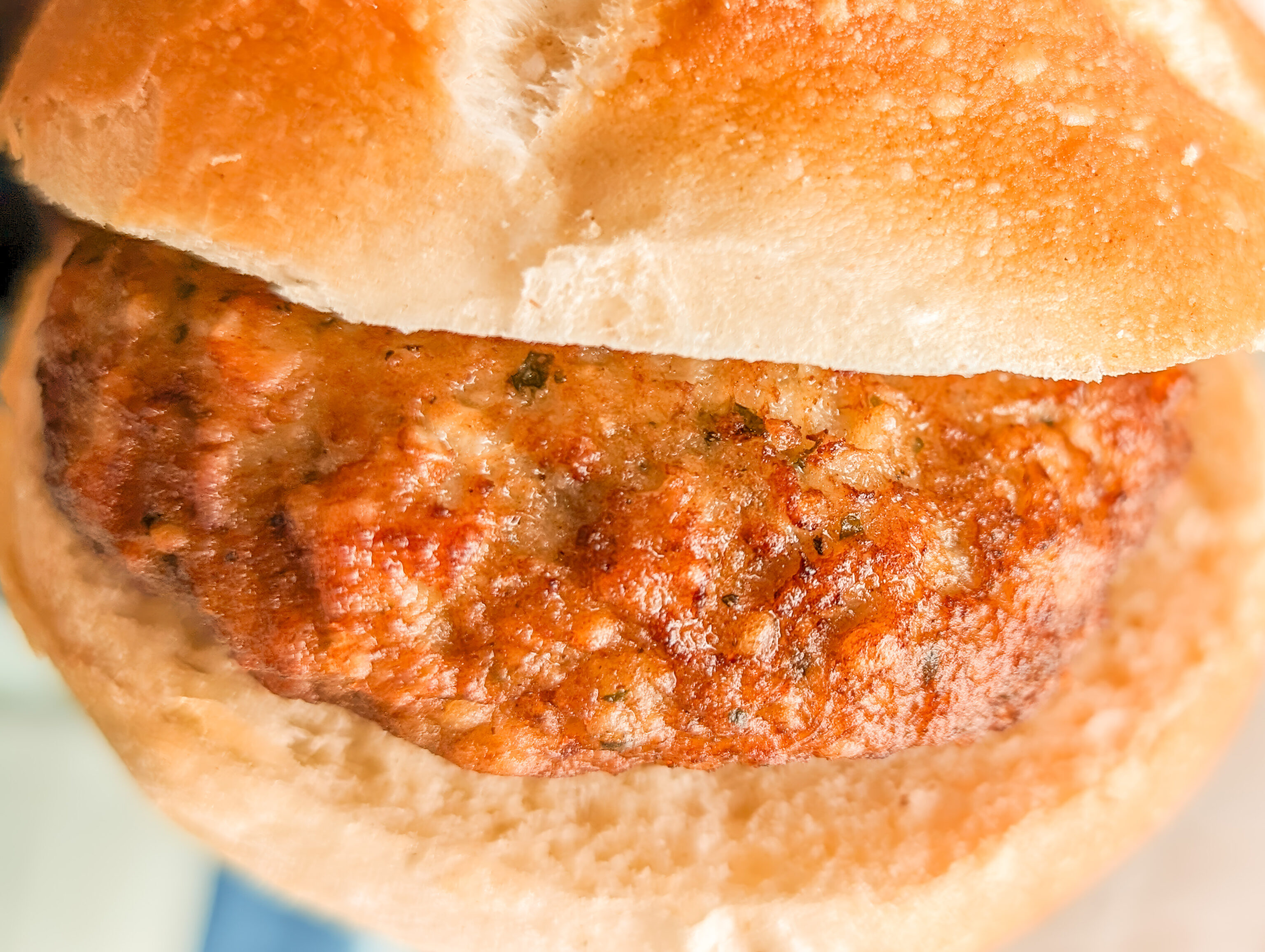
We went back to the snack bar to get what was described as a German hamburger. It was basically a patty-shaped meatball on a bun. It wasn’t particularly good but there aren’t really any good food options here. And, we weren’t ready to head back down yet.
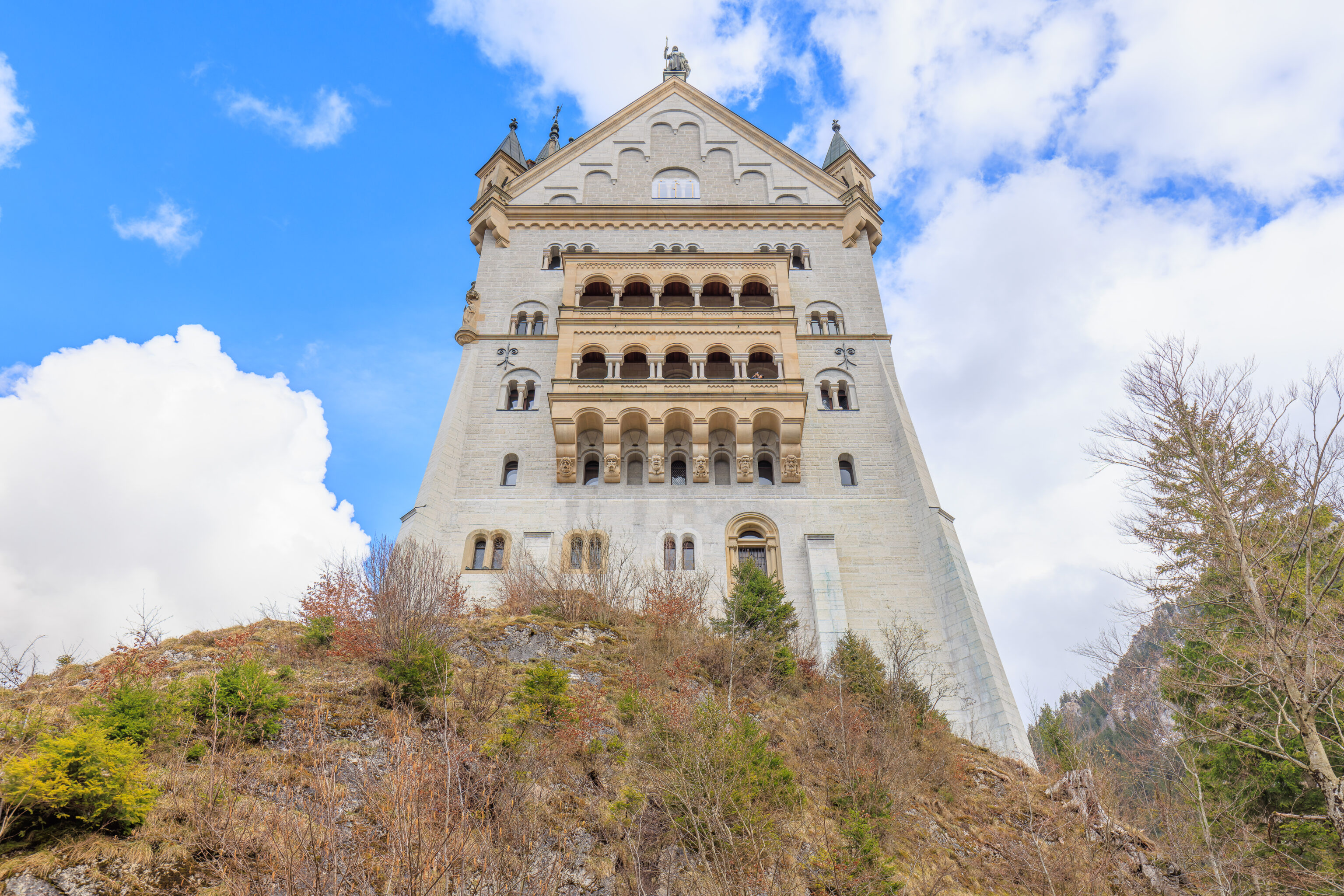
We continued on the path that we came up on, walking past the castle to the west. The path turned to the south where we had a great view of the castle. The balcony that we were previously at is right here above us.
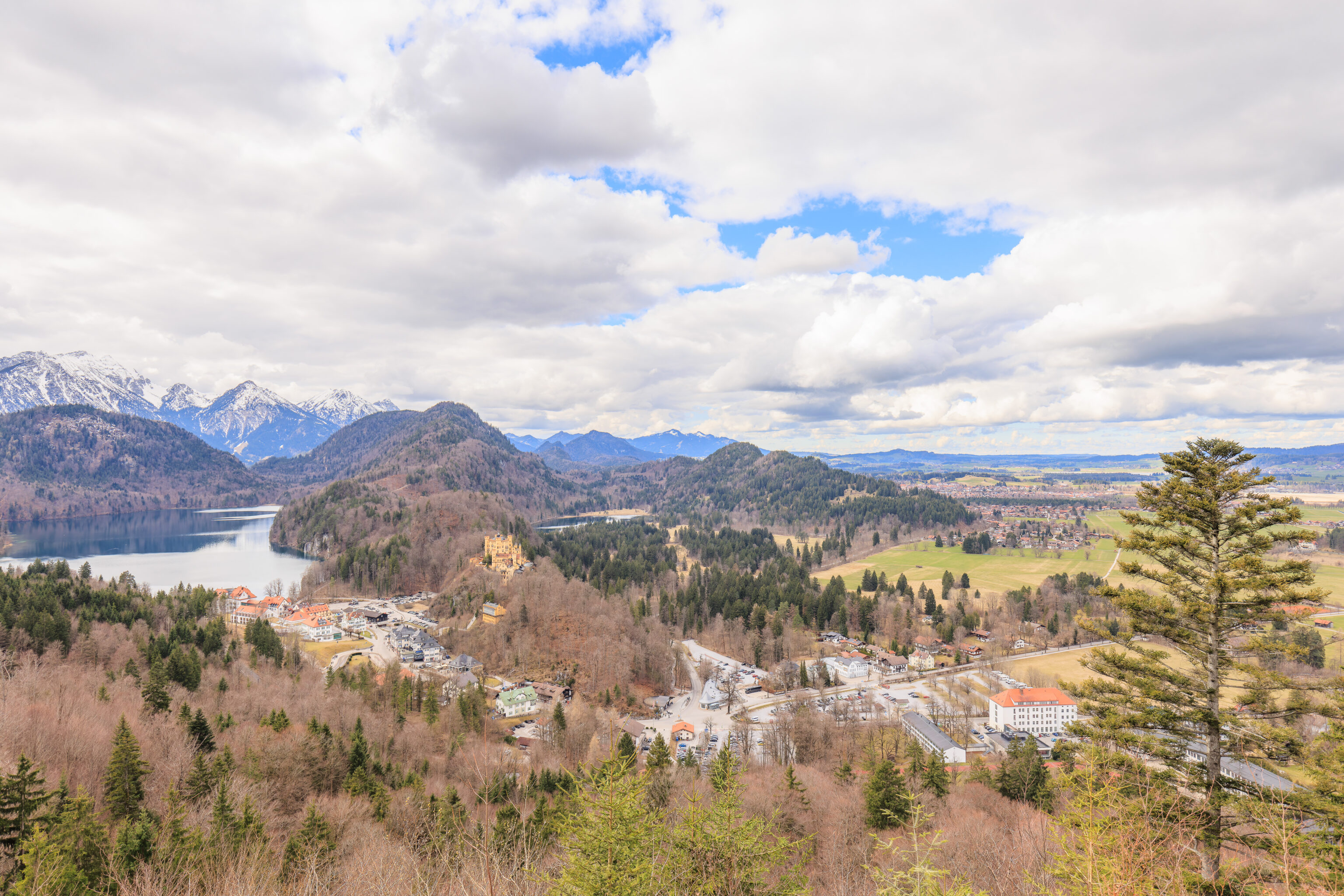
We continued following the path, on our way to the Marienbrücke. We passed by a nice view of Hohenschwangau below. This location is labelled as the Panoramablick Schwangau on Google Maps.
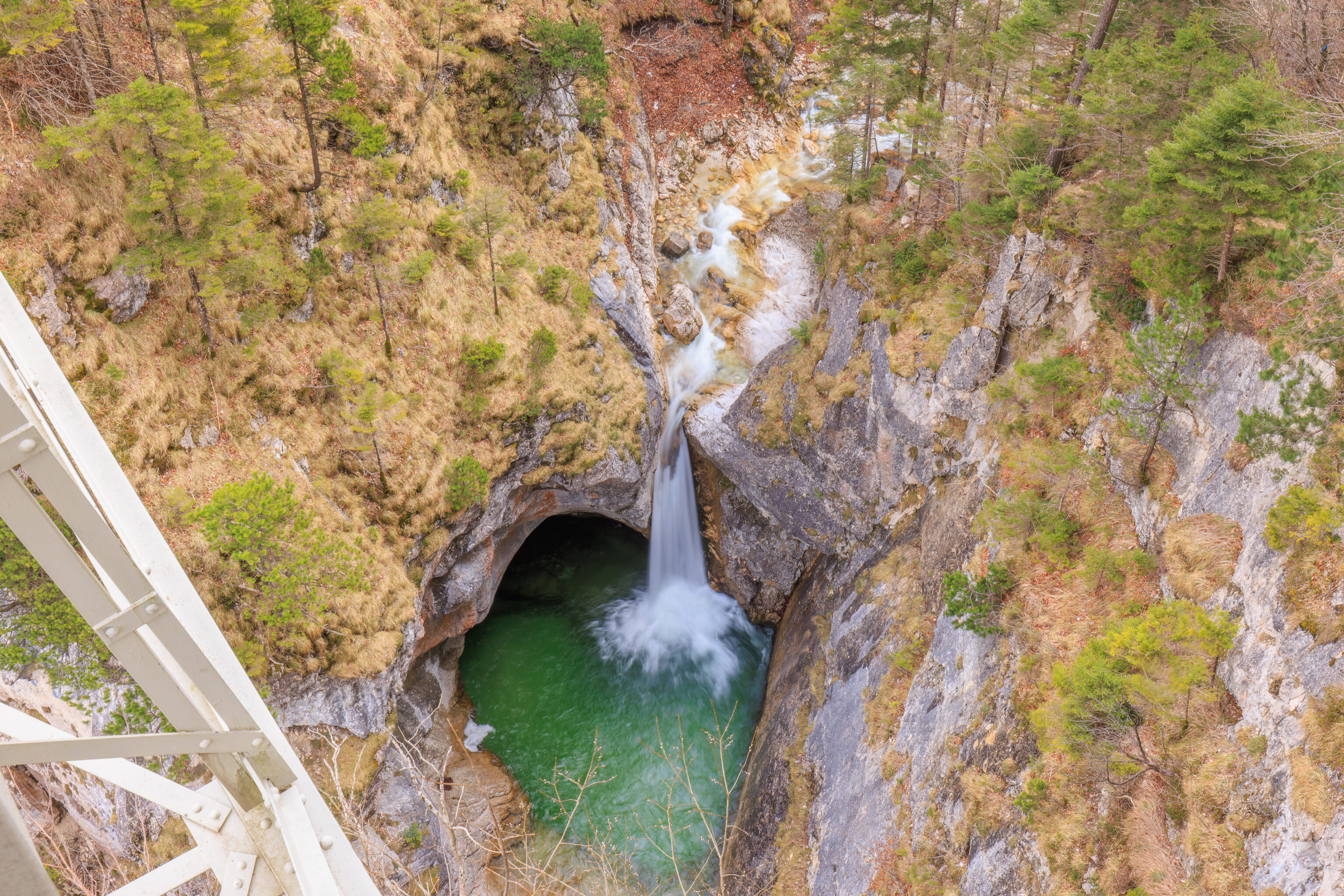
We soon made it to the bridge. It was quite busy when we arrived. The bridge is narrow so we had to slowly make our way out onto the bridge as everyone was taking photos and selfies. The bridge spans a ravine with a river below. We looked down to see a small waterfall.
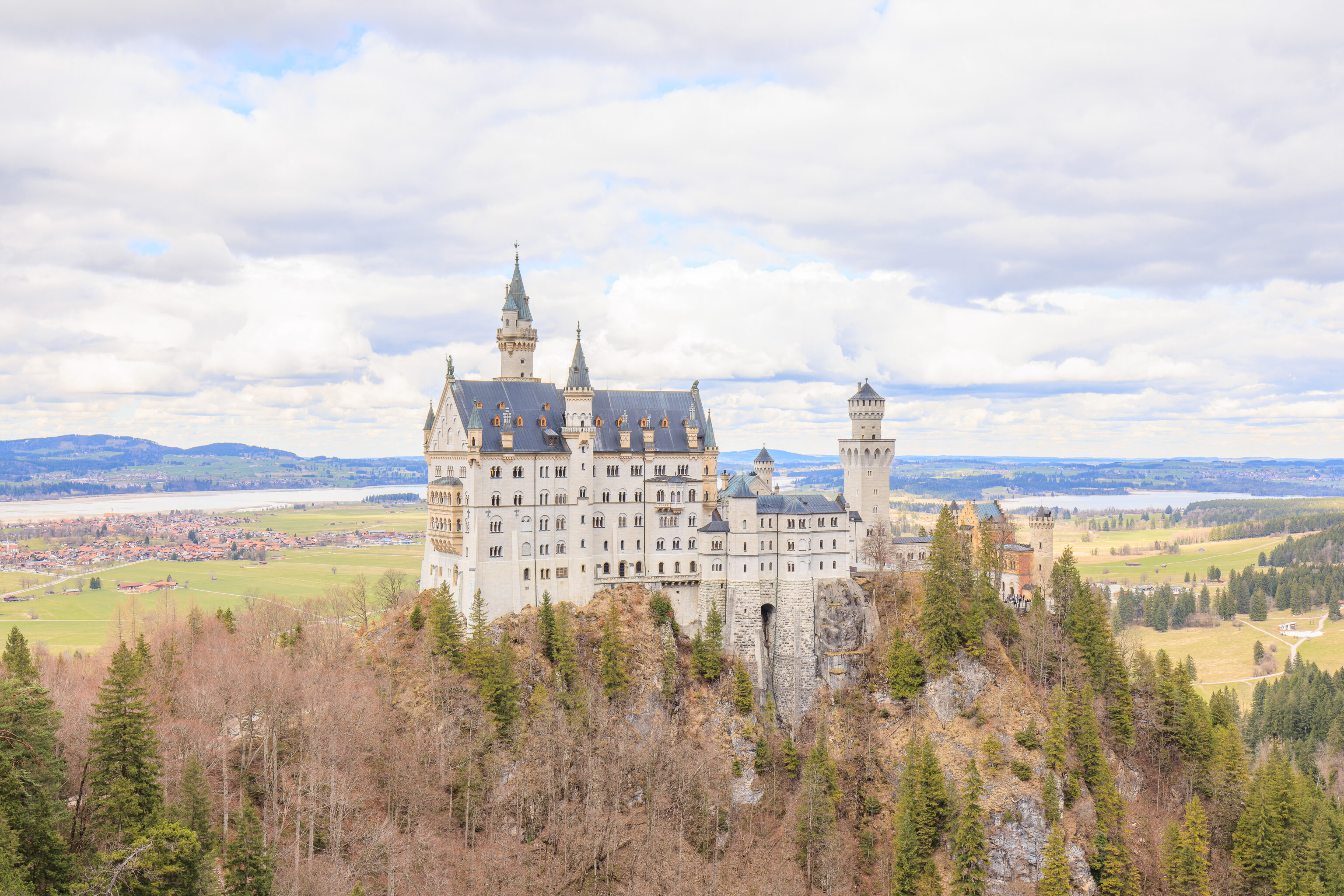
The view of the castle from the bridge is fantastic! It really looks as if it is perched at the very tip of a tall mountain.
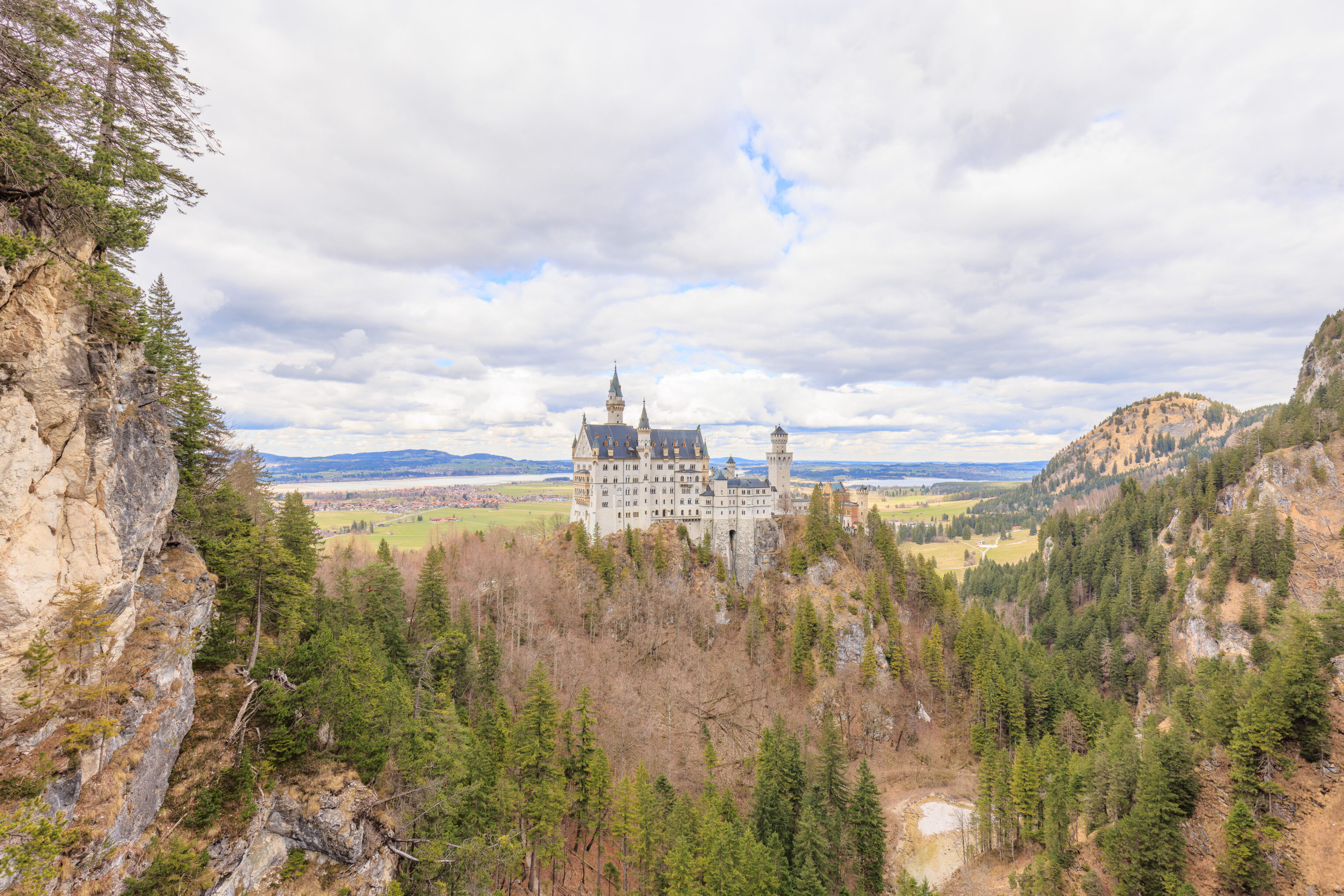
A wide angle view of the scene.
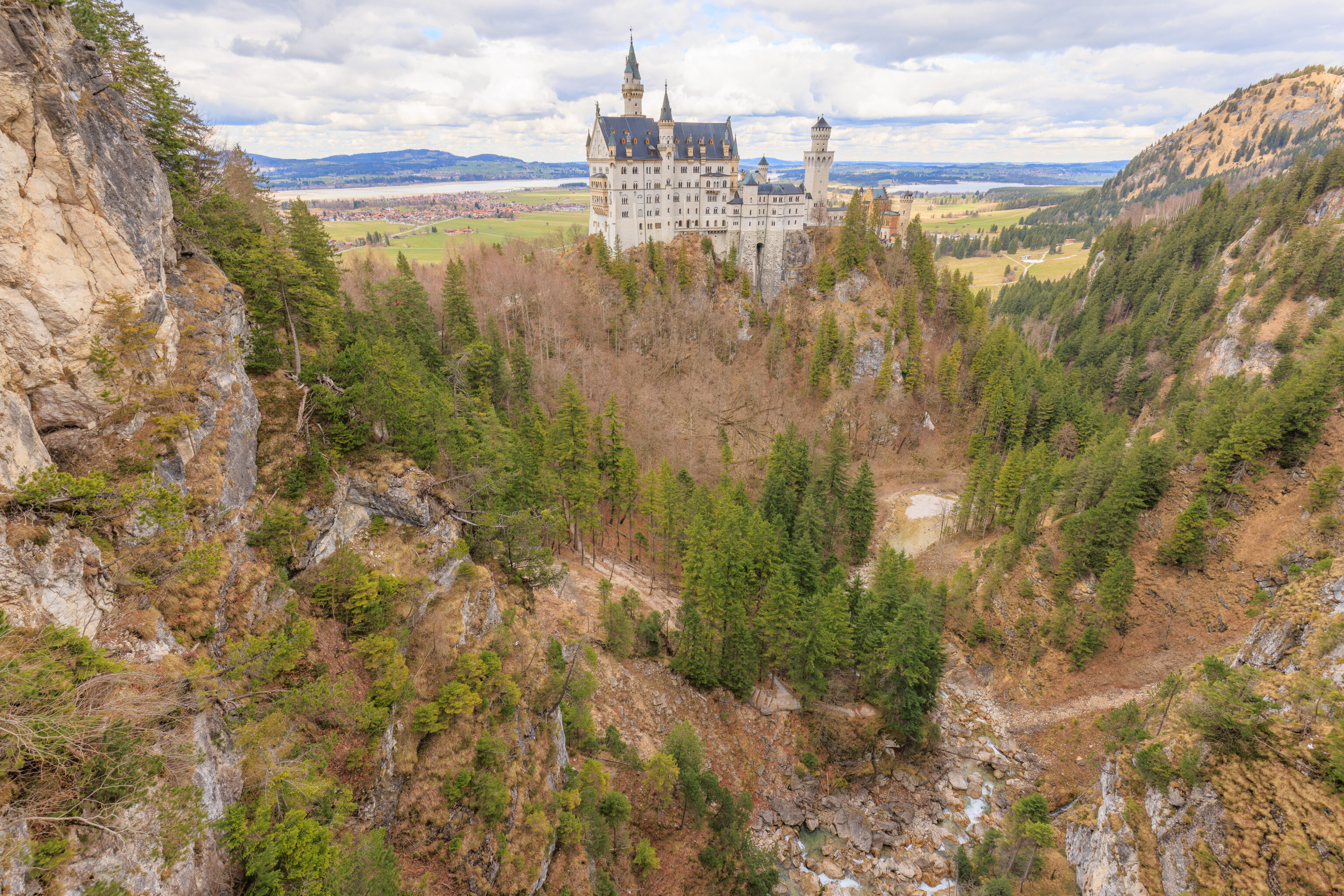
And the view looking down a bit from the same place. The river can be seen below as well as a path through the forest and some stairs.
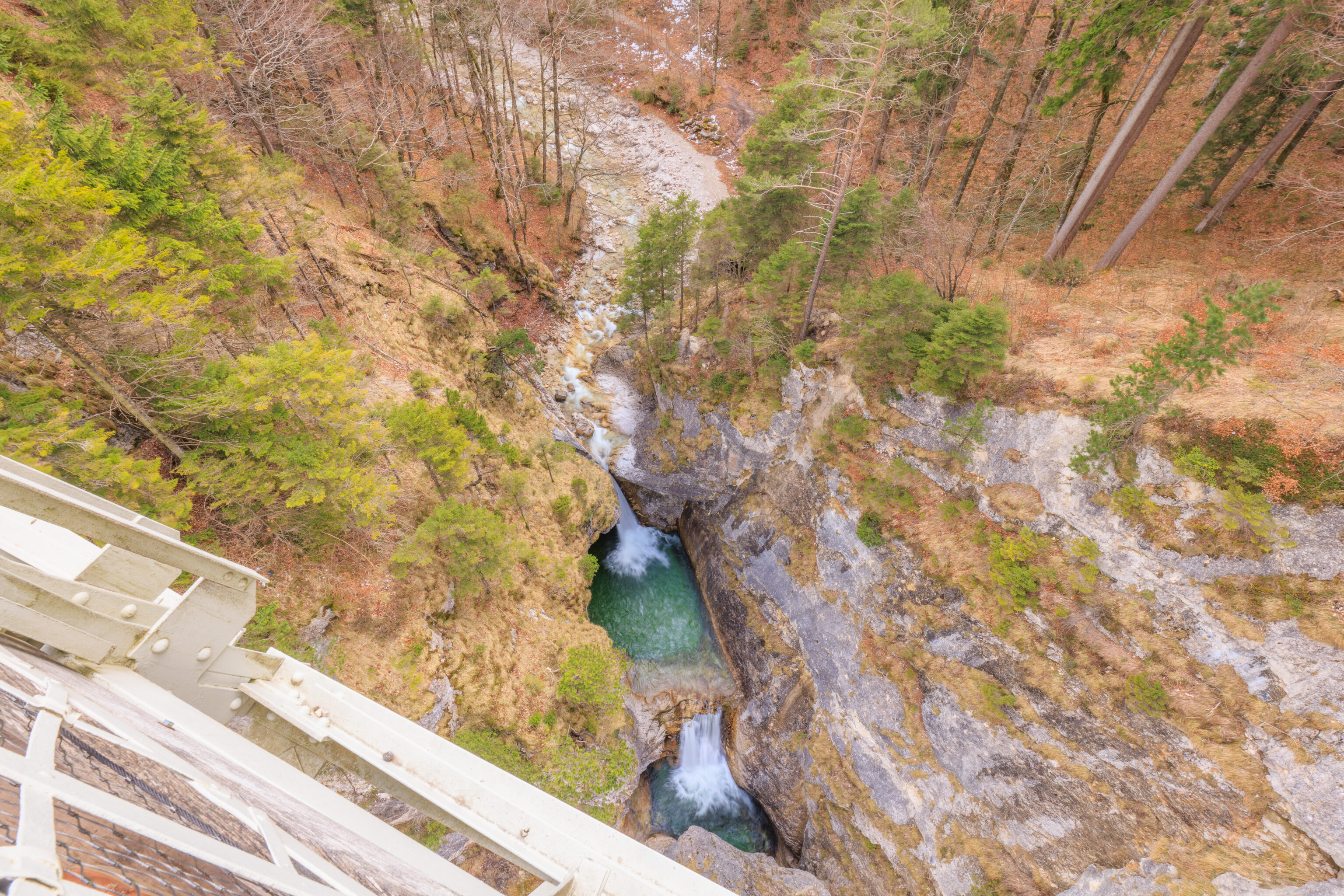
Another waterfall view from further along the bridge.
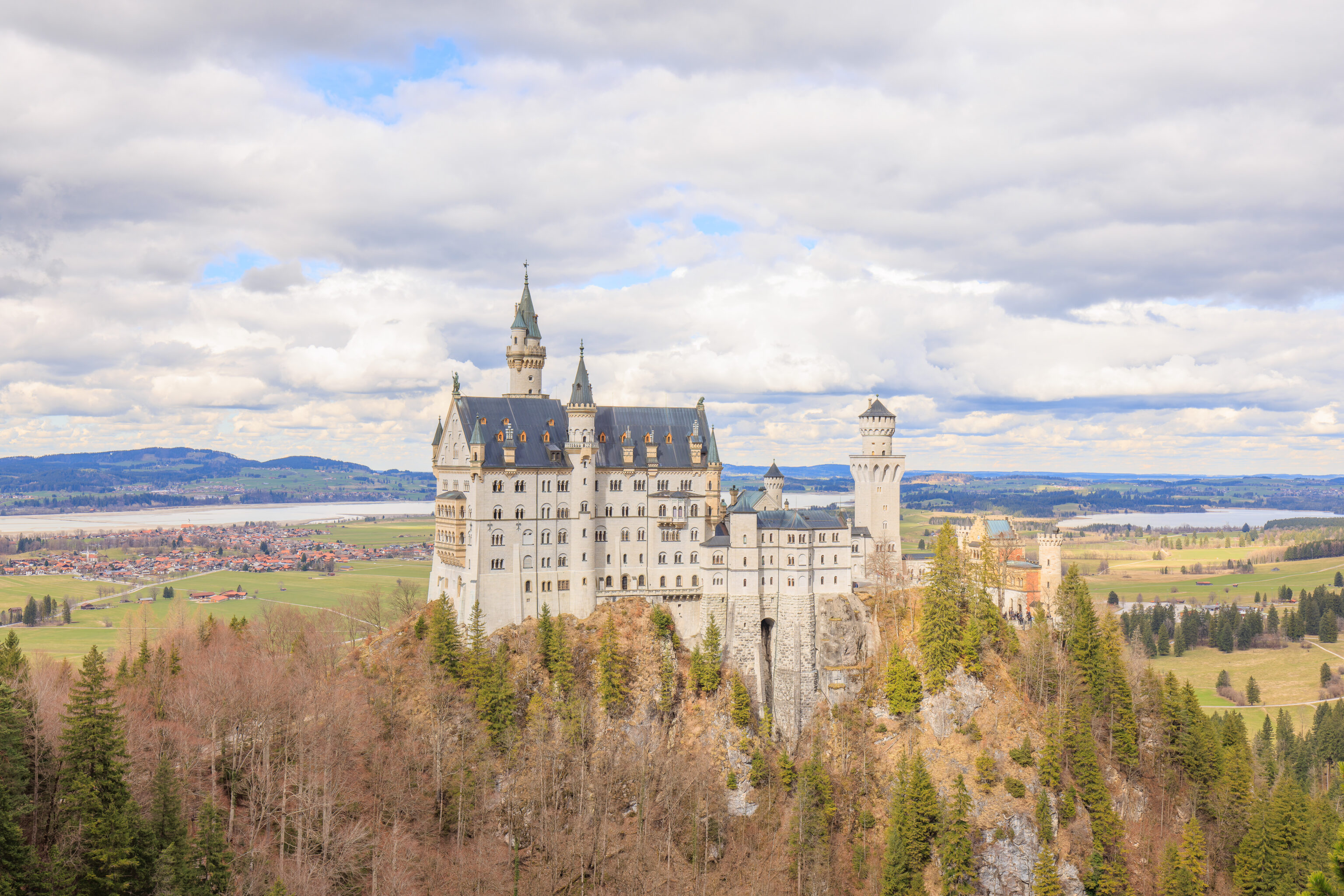
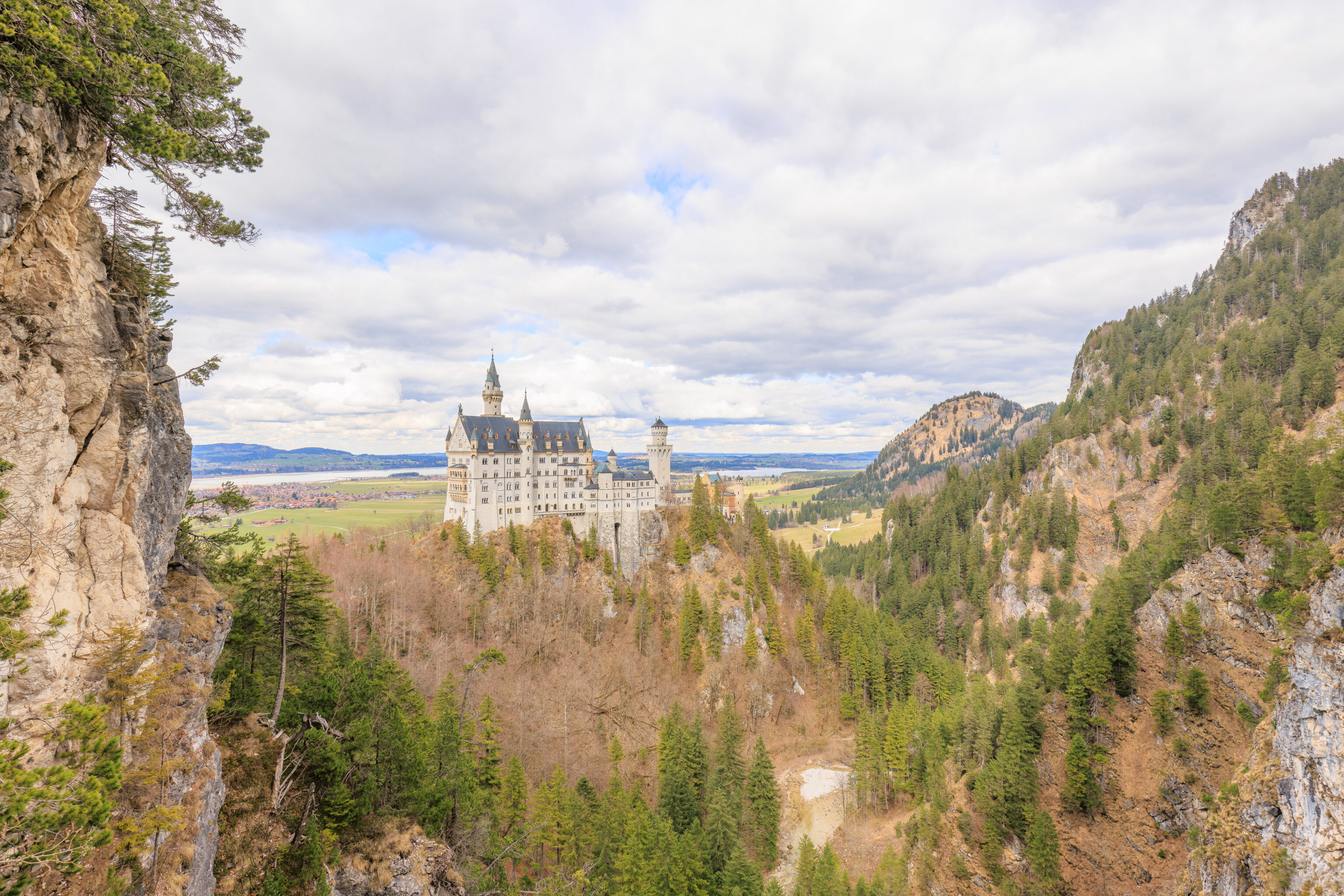
The bridge isn’t long enough for the views to look substantially different from either end. We did walk to the far side though before turning back.
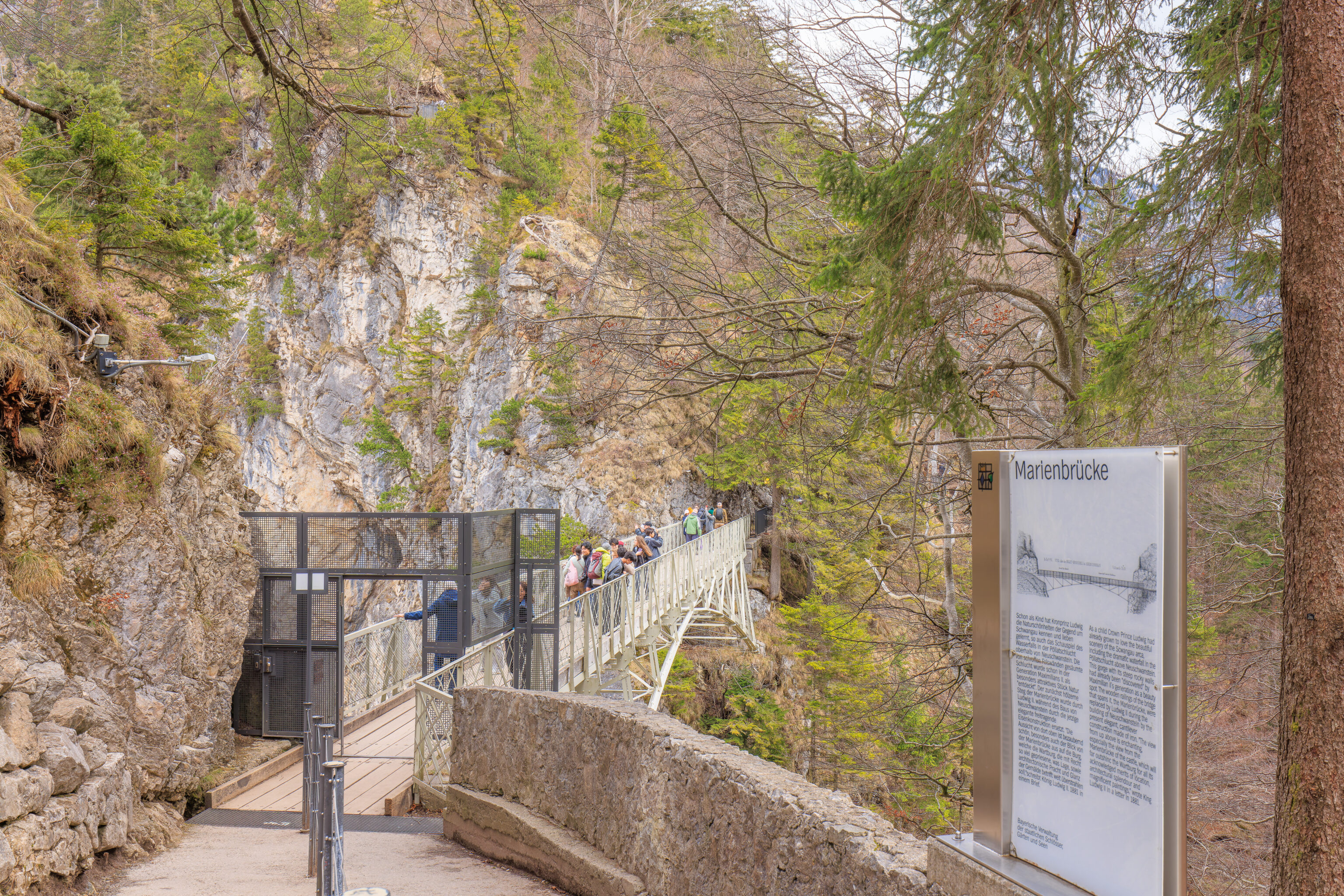
The bridge as seen from the west end, where we arrived from. The English text on the sign reads:
As a child Crown Prince Ludwig had already grown to love the beautiful scenery of the Scwangau area, including the dramatic waterfall in the Pöllatschlucht above Neuschwanstein. This gorge with its steep rocky walls had already been "discovered" by Maximilian II's generation as a beauty spot. The wooden railings of the bridge that spans it, the Marienbrücke, were replaced by Ludwig II during the building of Neuschwanstein by the present elegant, cantilever construction made of iron. "The view from up above is enchanting, especially the view from the Marienbrücke of the castle, which will far outshine the Wartburg for all its acknowledged merits of location, architectural splendour and magnificent paintings," wrote King Ludwig II in a letter in 1881.
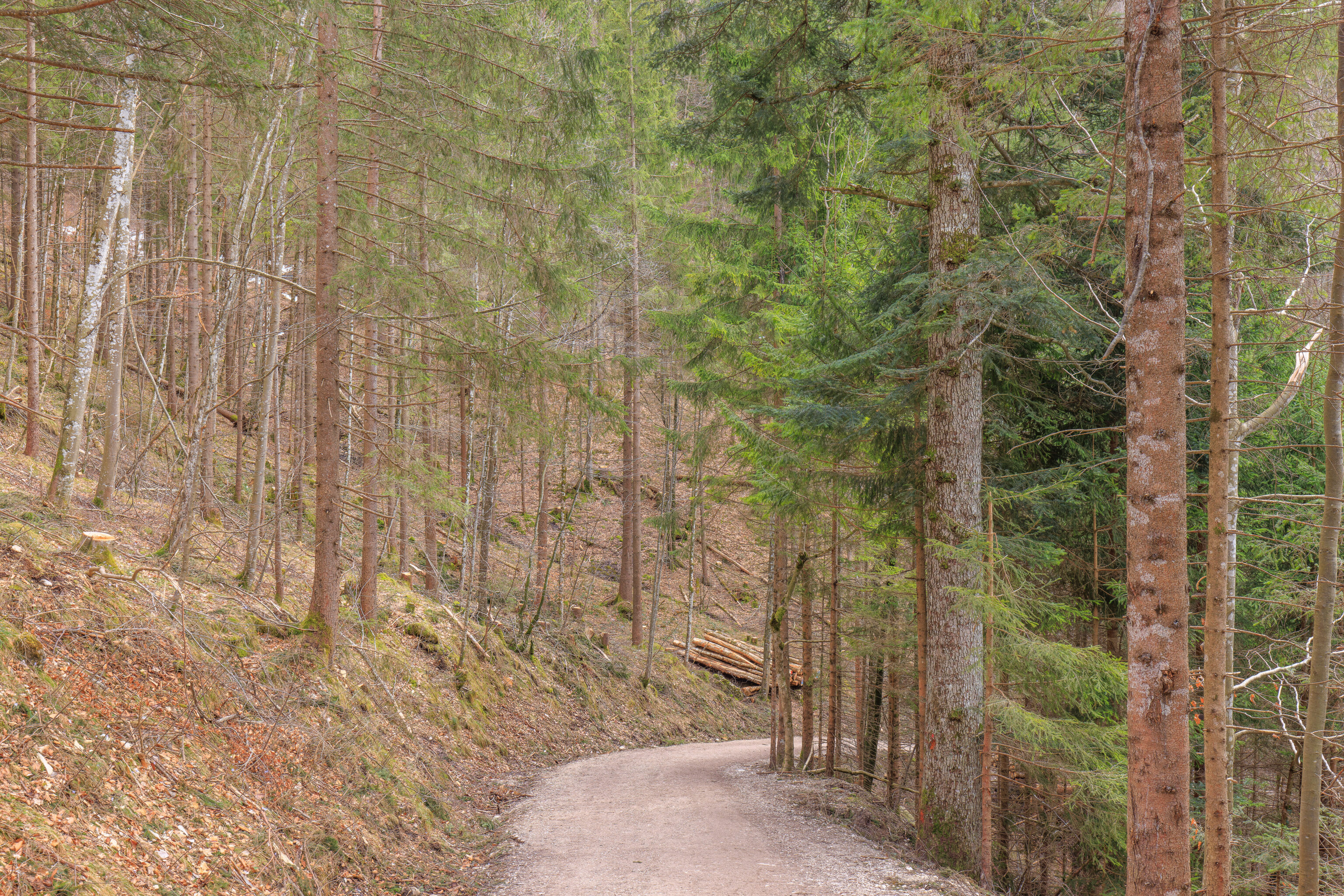
After leaving the bridge, we started to head back down to Hohenschwangau. We decided to take a different route along a narrow unpaved path, which ended up being somewhat steep in places.
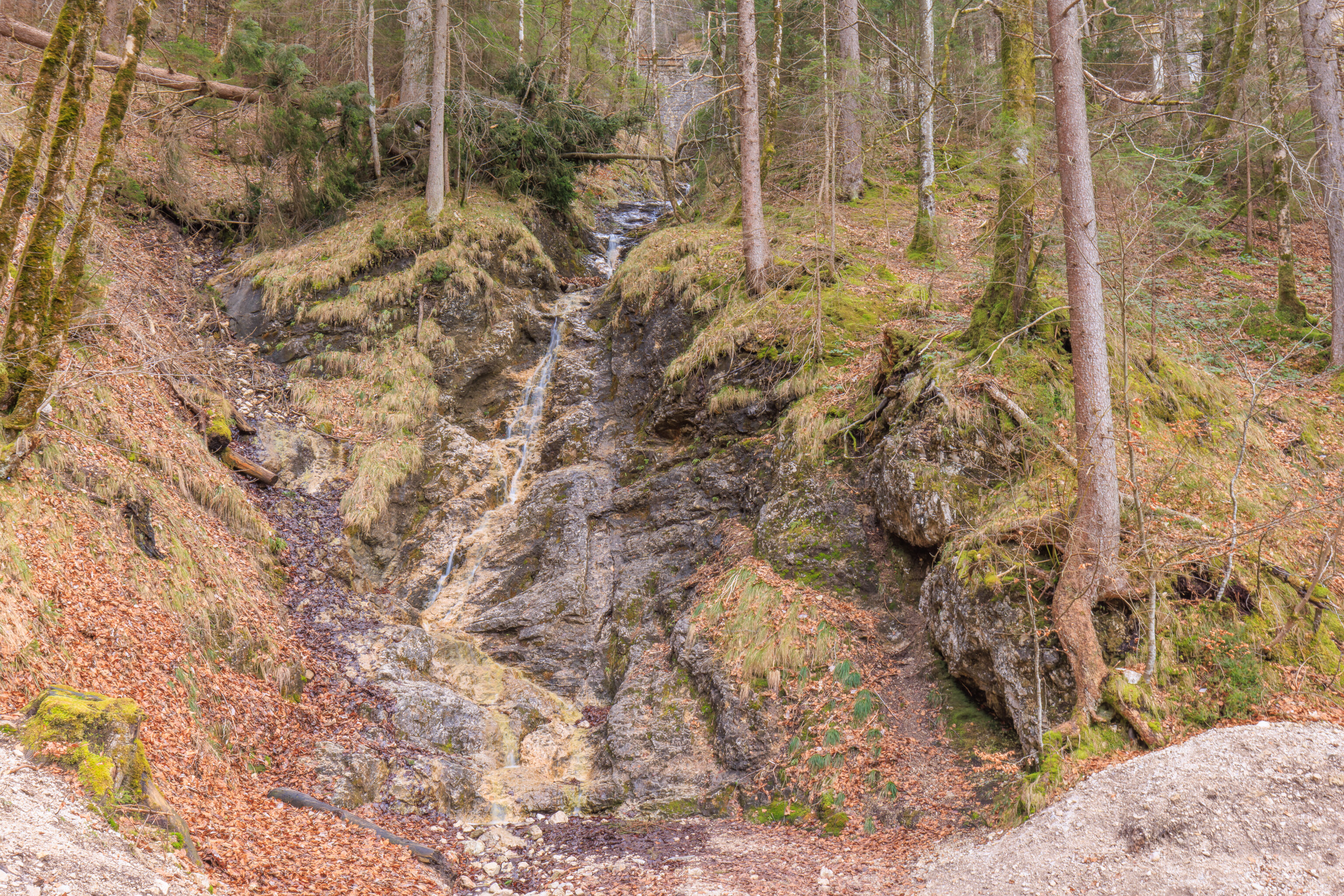
There wasn’t really any particularly interesting scenery on the way down, though we did again pass a small waterfall. It also felt like a longer route, though it likely was actually shorter due to not needing to backtrack to the castle.
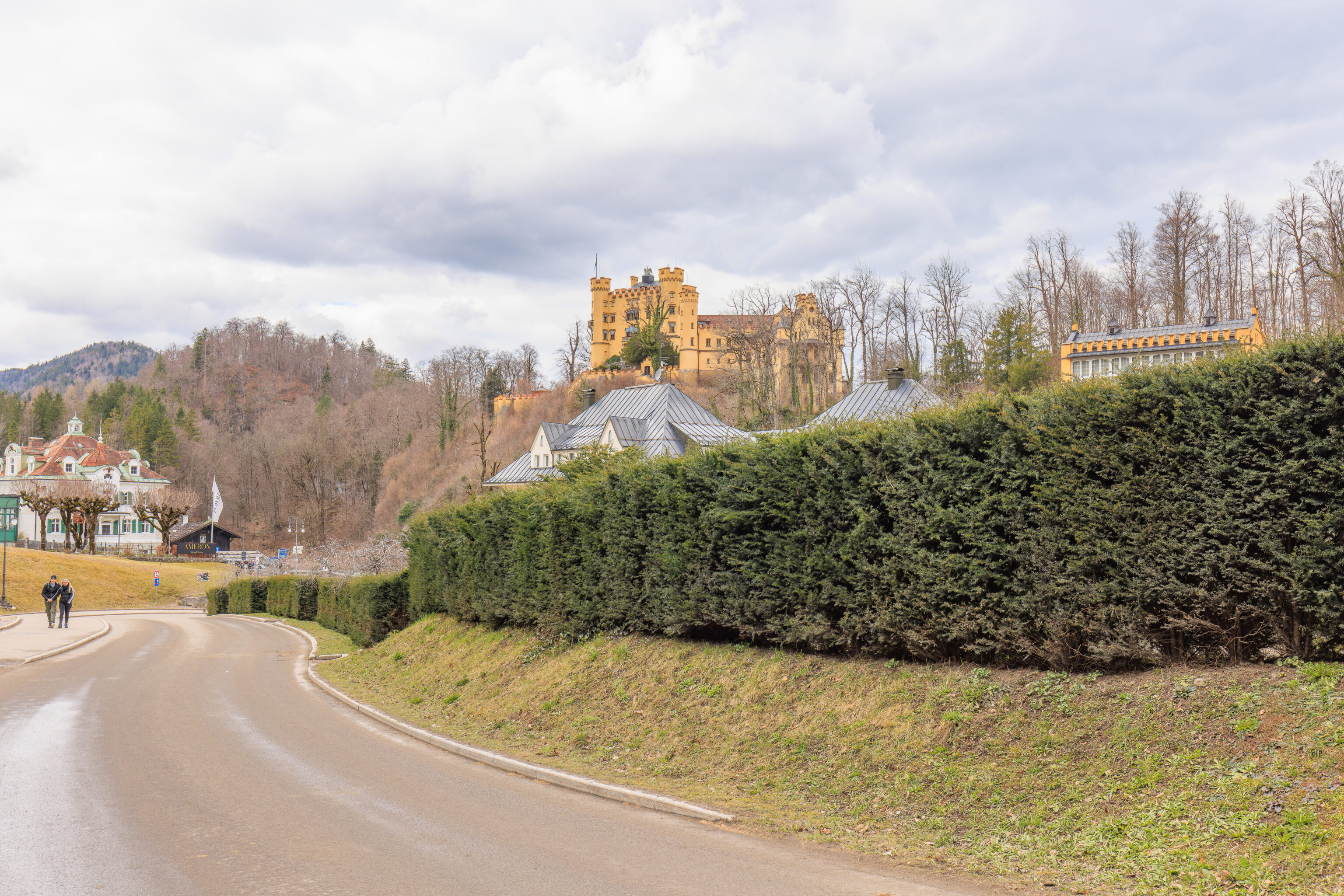
We soon were back in Hohenschwangau and saw the Schloss Hohenschwangau in front of us.
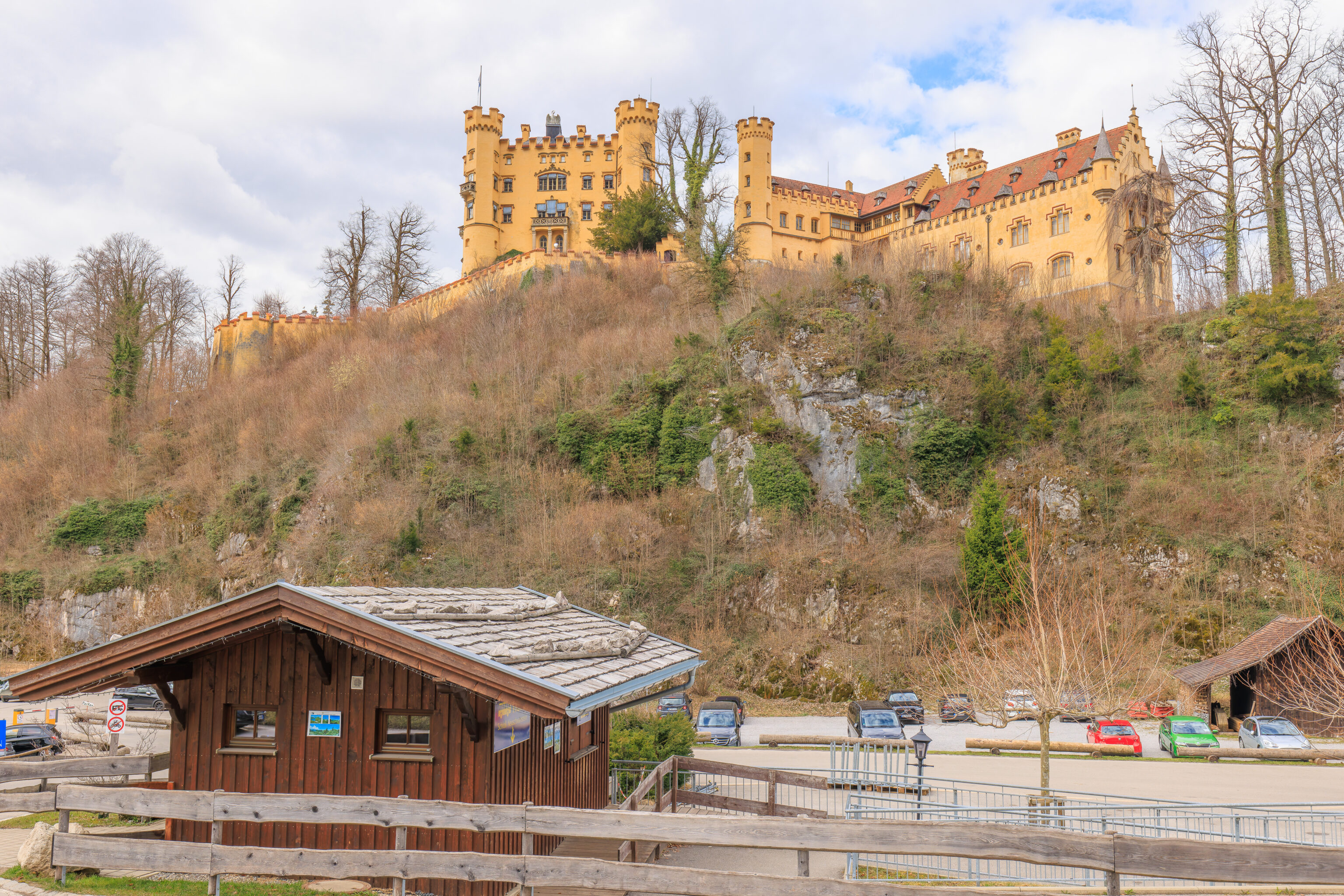
We decided to keep walking past the schloss to the small lake to the west.
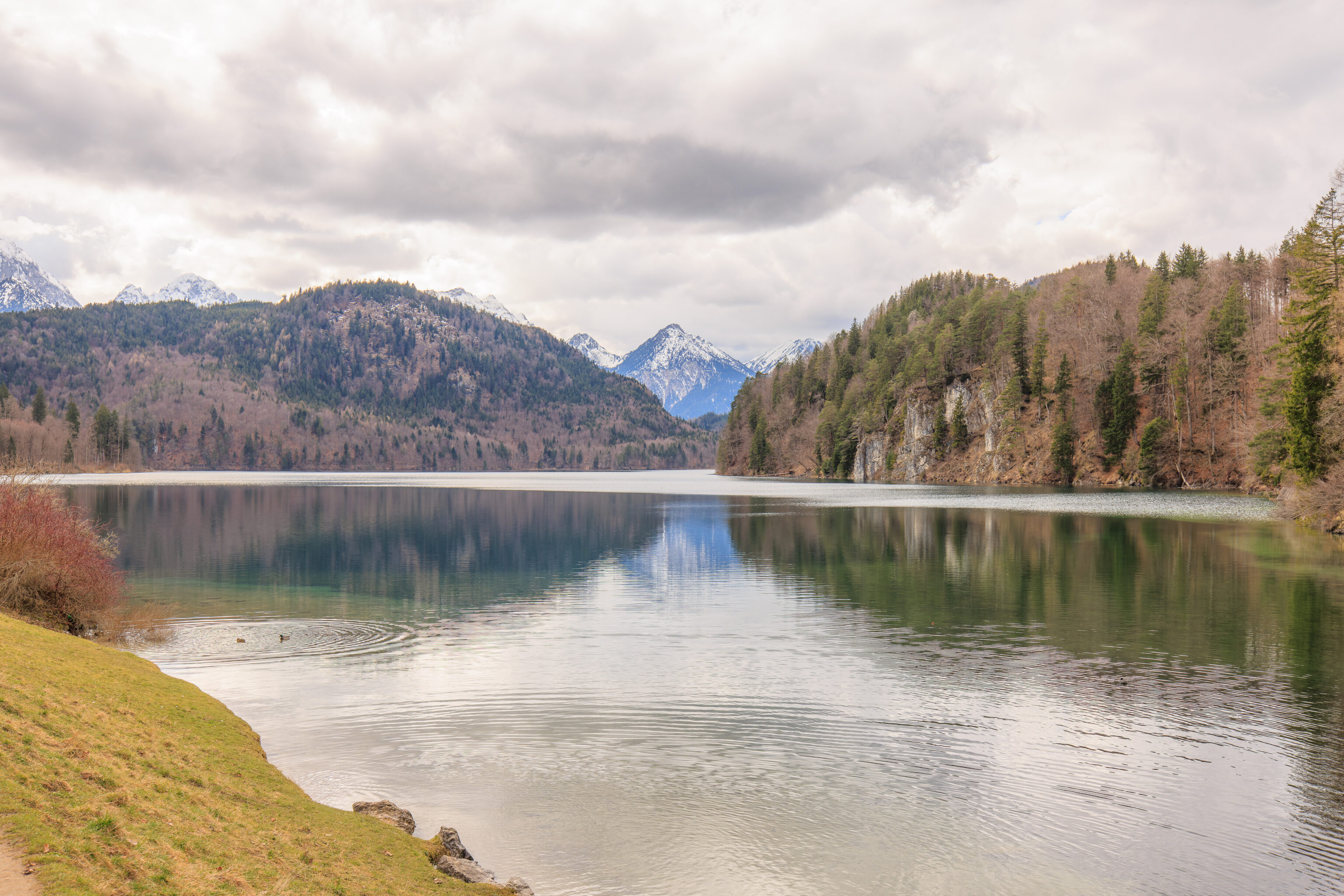
The lake seems to be simply referred to as the Alpsee, a descriptive name. The weather was, unfortunately, not as good as it was in the morning when we had a beautiful blue sky above.
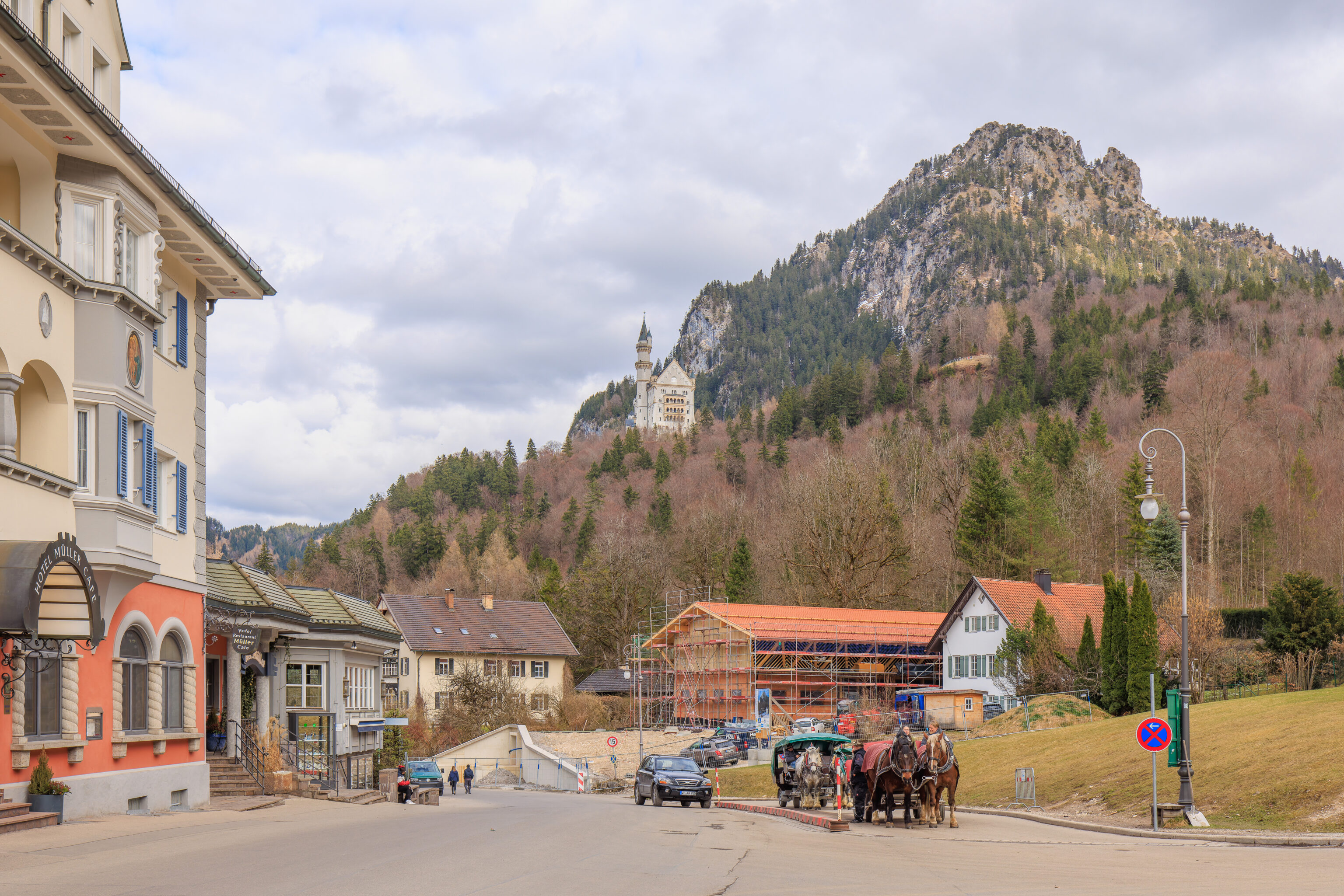
We turned around to head back to the bus stop to return to Munich. We had one last view of Neuschwanstein as we walked down the road, the same view we had in the morning.
Return to Munich
After catching the bus, we quickly made it back to the train station in Füssen. There are a few trains that go directly to Munich but we caught the next one to Buchloe. At Buchloe, we walked a few blocks through the town to have an early dinner.
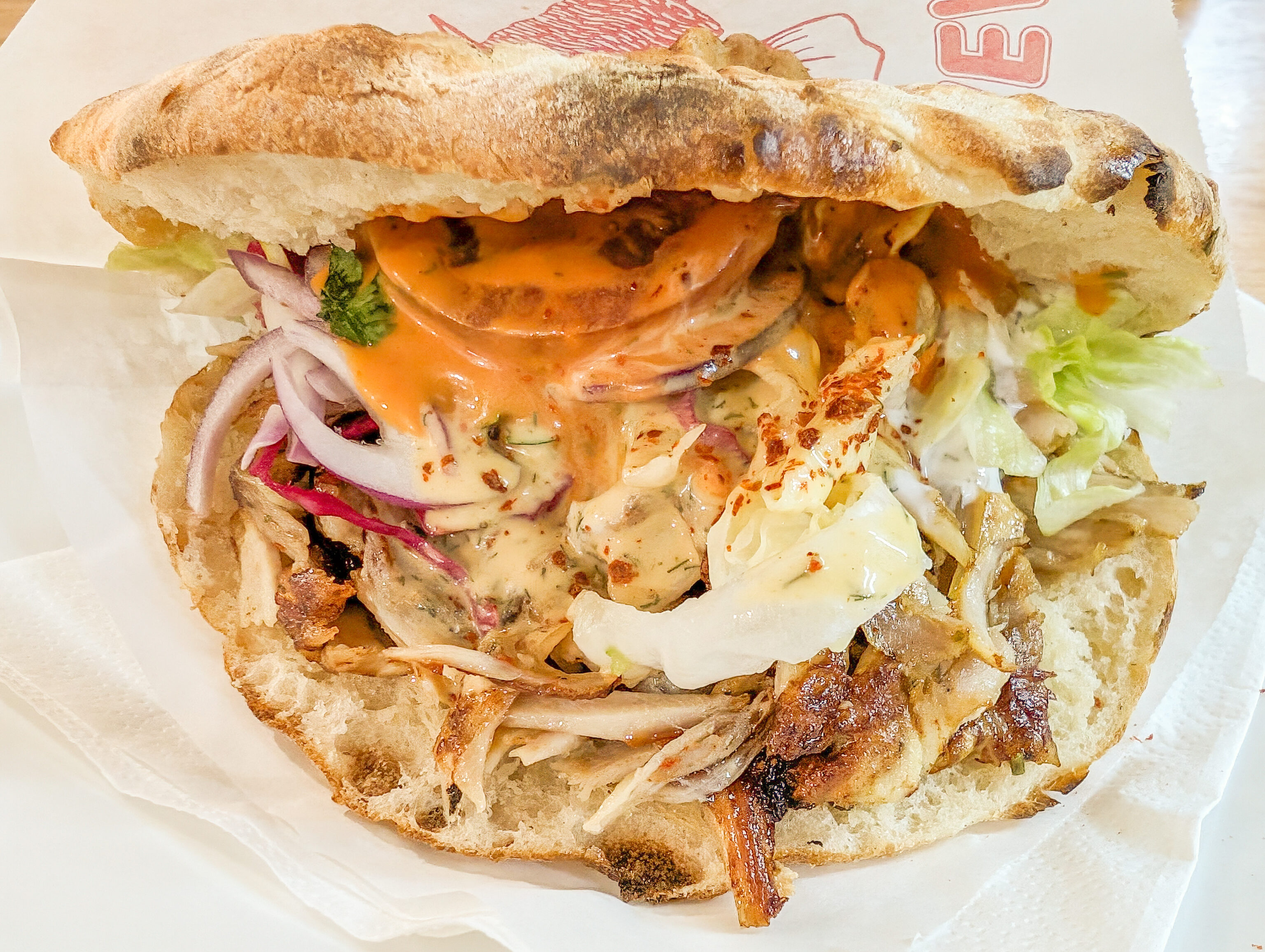
We ended up at the Alaturqua Kebabhaus. It wasn’t busy at the time as it was early for dinner. The döner here was a bit different than the ones we’ve had before due to the sauce. It was slightly sweet with a slight fruity flavor. Ultimately, it was pretty good.
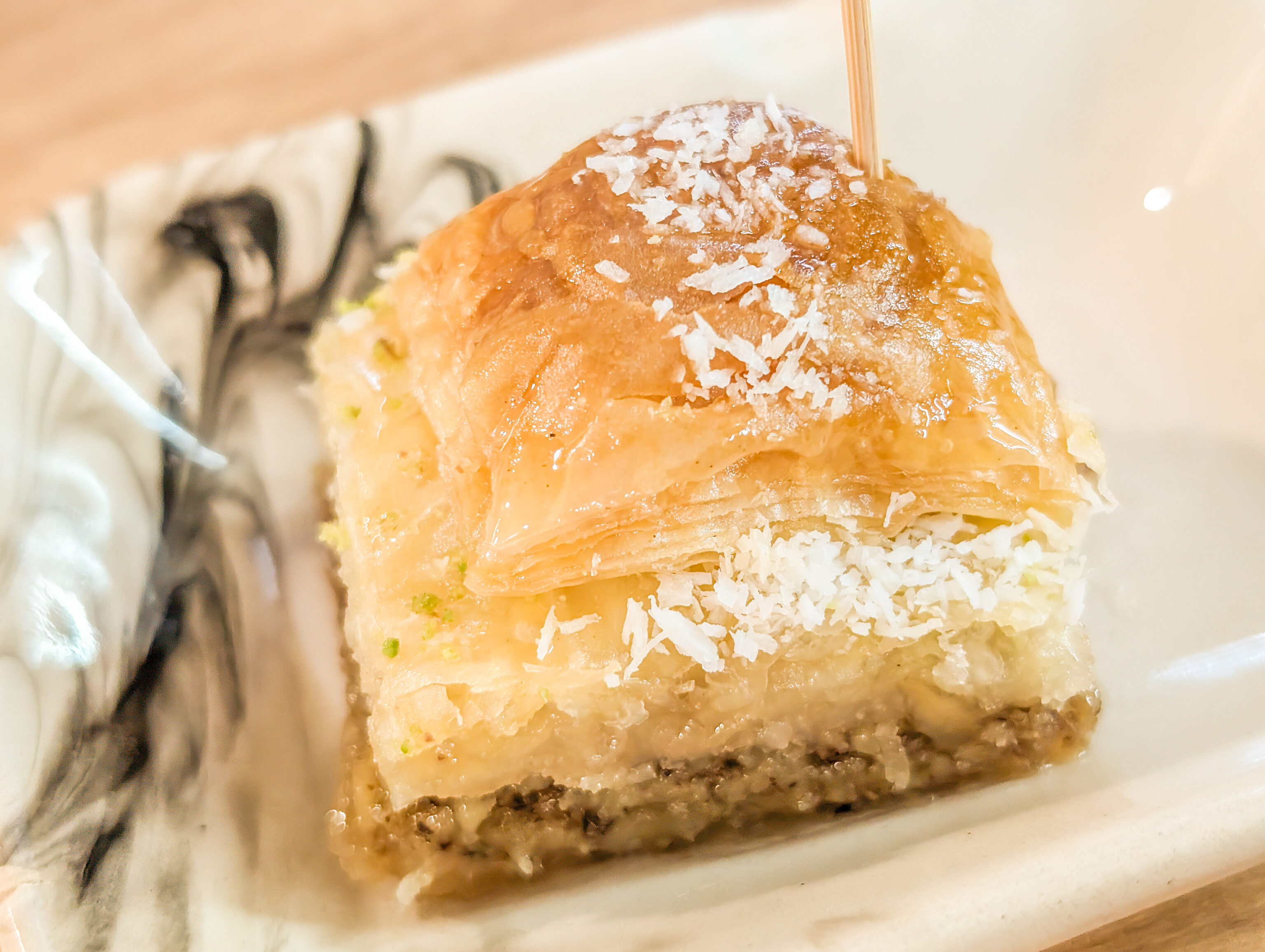
We also had Baklava.
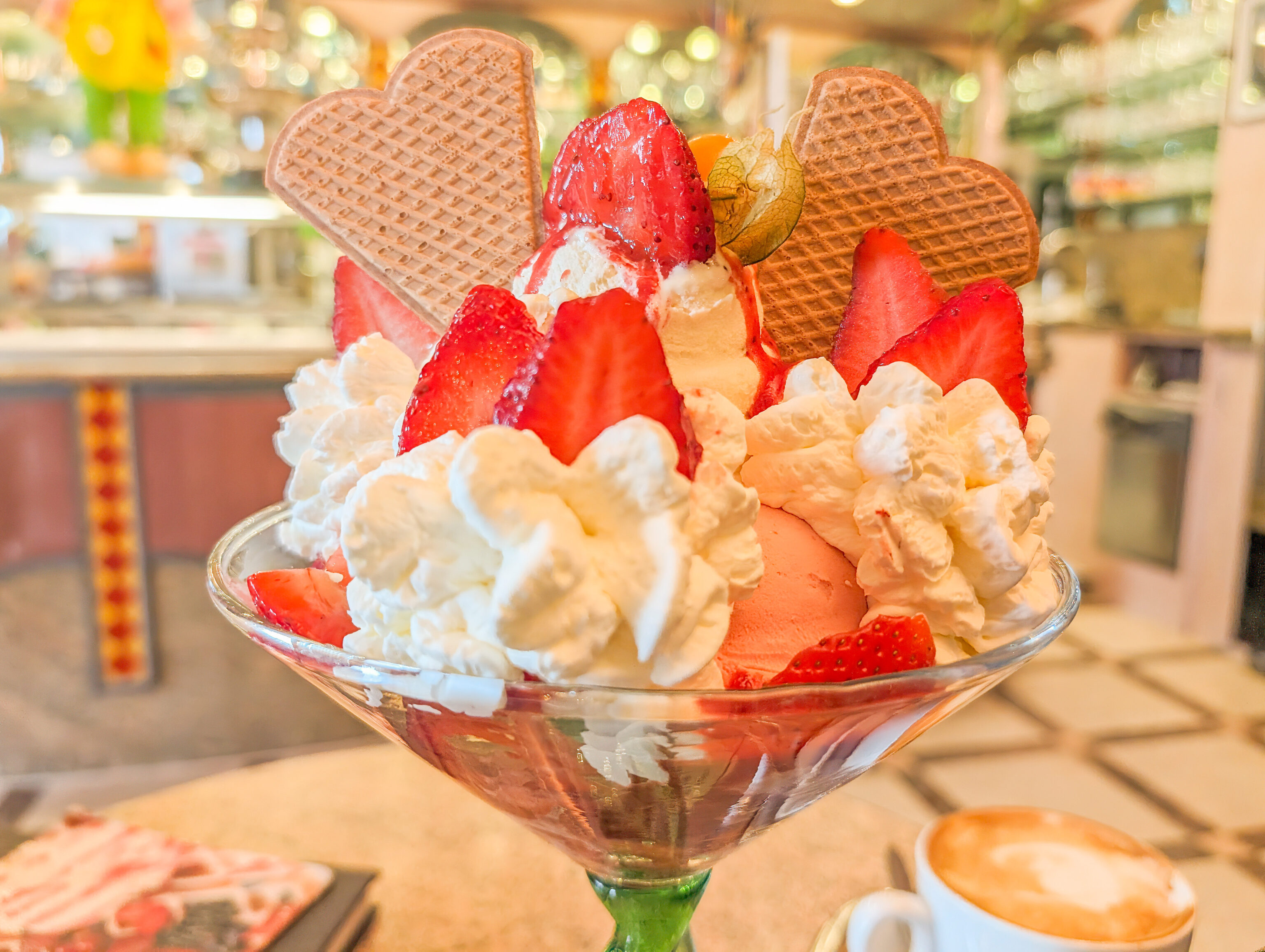
After, we walked around the corner to visit Eiscafé Venezia. We ordered the Groß Erdbeer Becher and a cappuccino for something warm. It ended up being much larger than we expected!
We then returned to the train station to catch the next train to Munich. Our flight out is tomorrow afternoon.
A strike was announced in this afternoon for Deutsche Bahn tomorrow as the union is no longer going to give advance notice of strikes. The effects of the strike seem uncertain but there will likely still be S-Bahn service to the airport tomorrow, as well as other transportation options if necessary. Also, Lufthansa cabin crew are on strike today in Frankfurt and will be on strike tomorrow in Munich. Luckily, we are not flying on Lufthansa!
